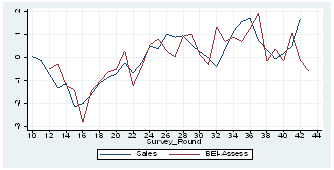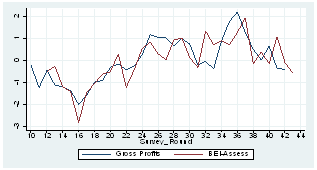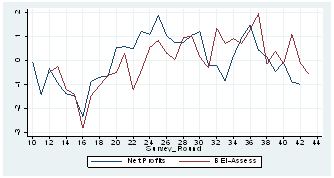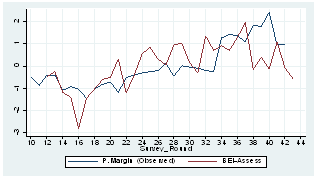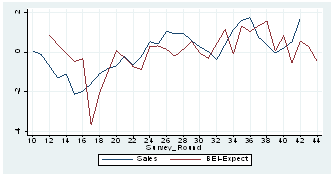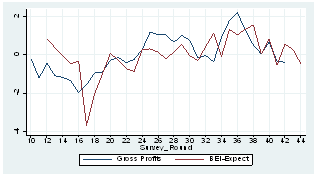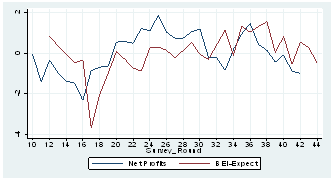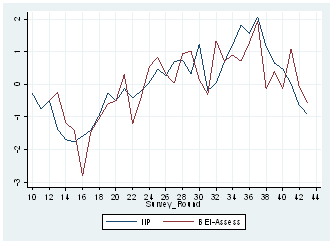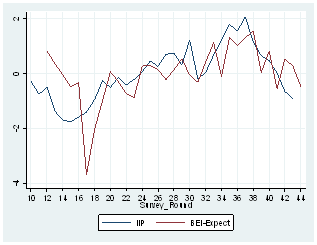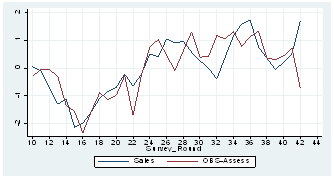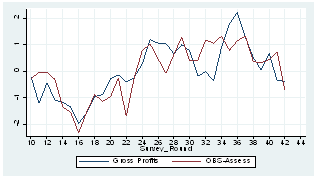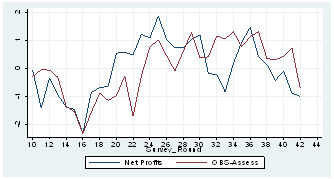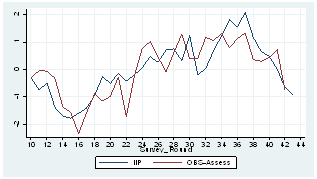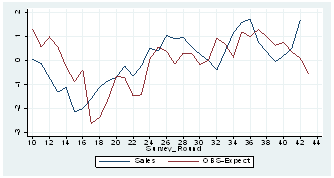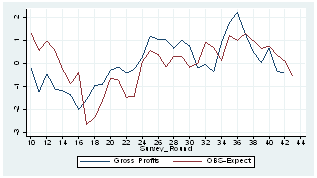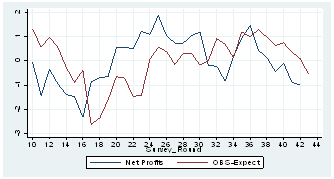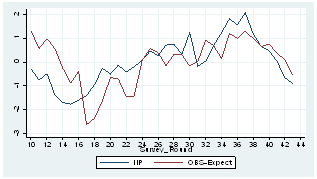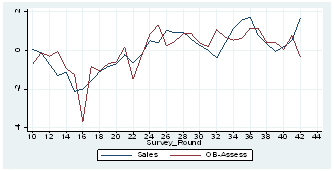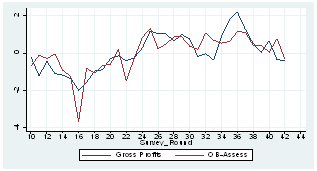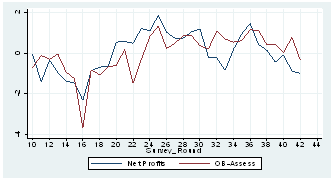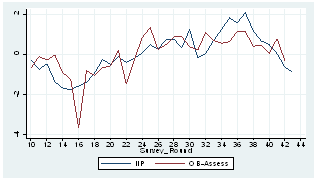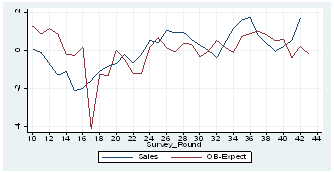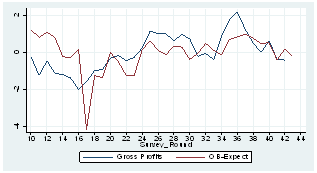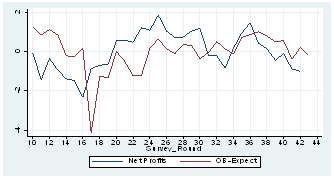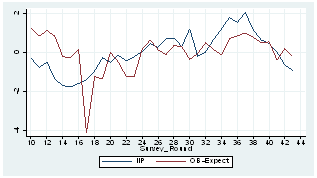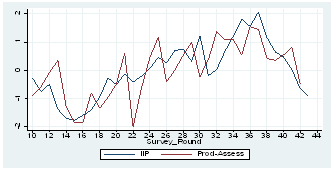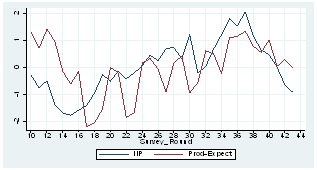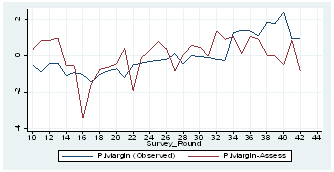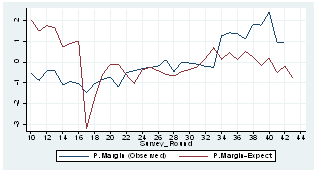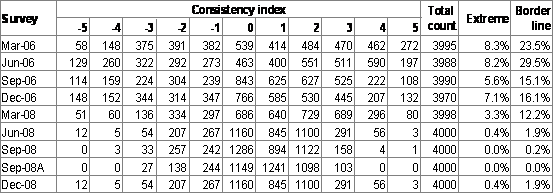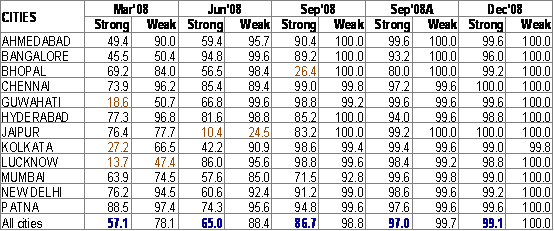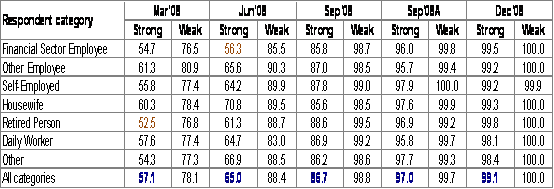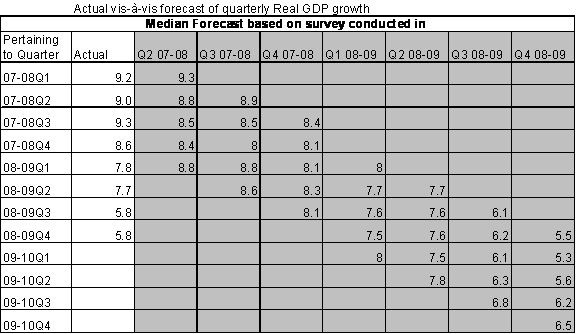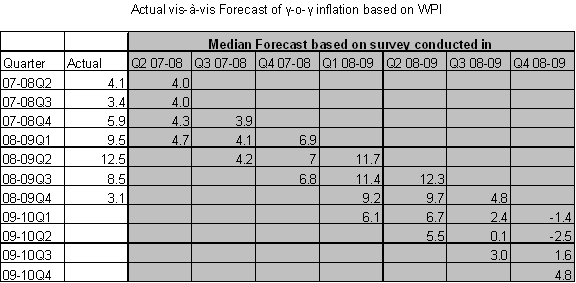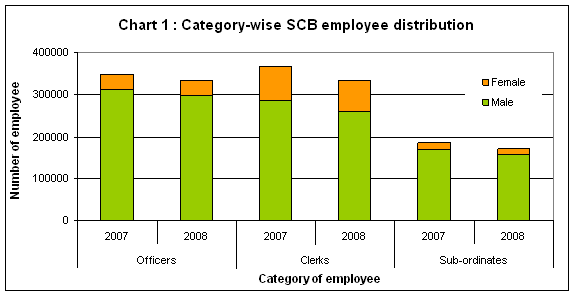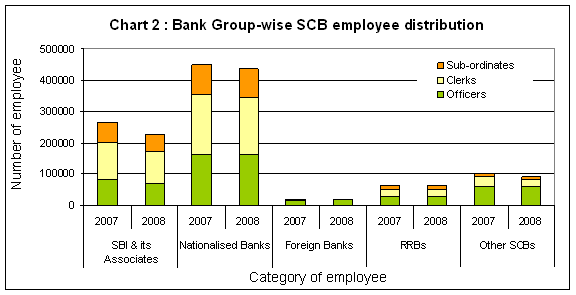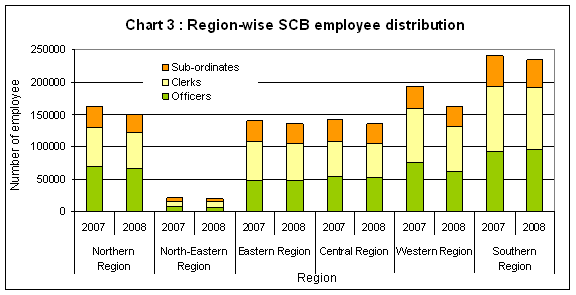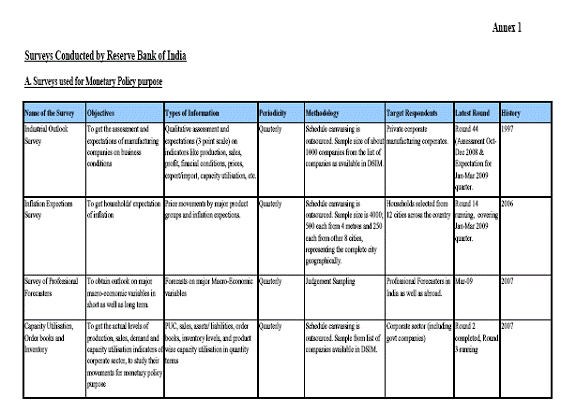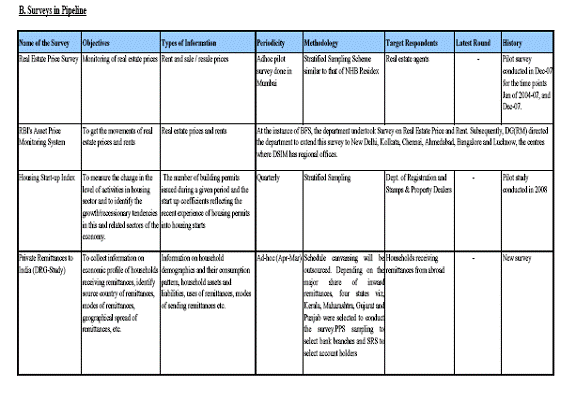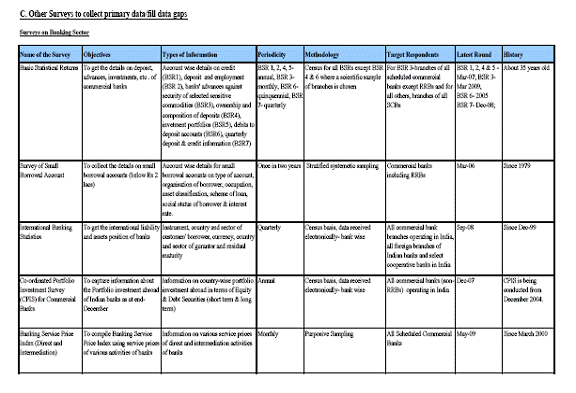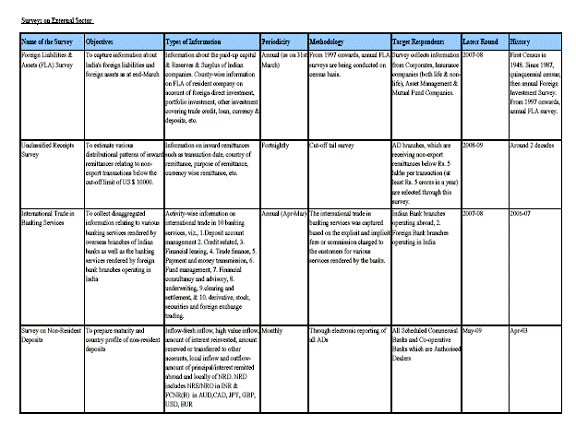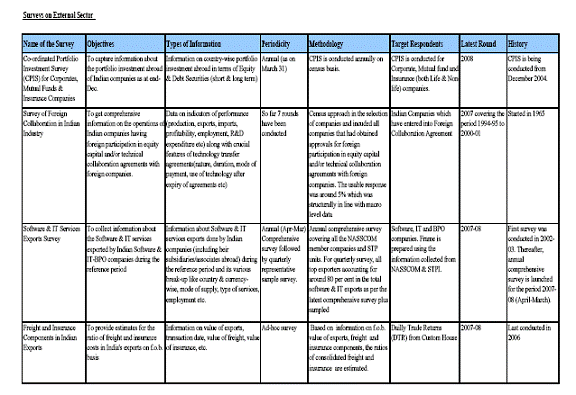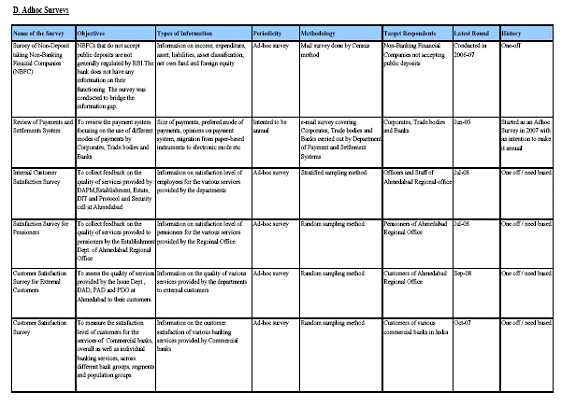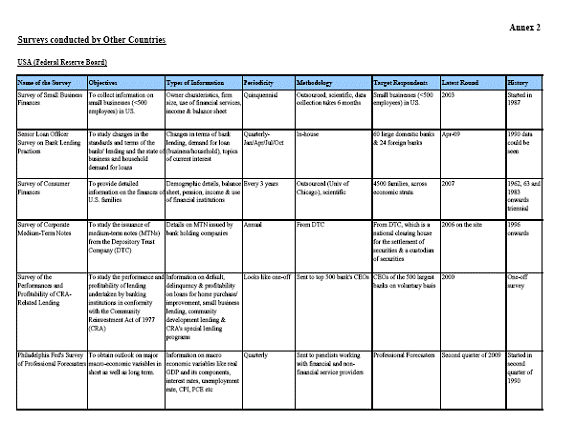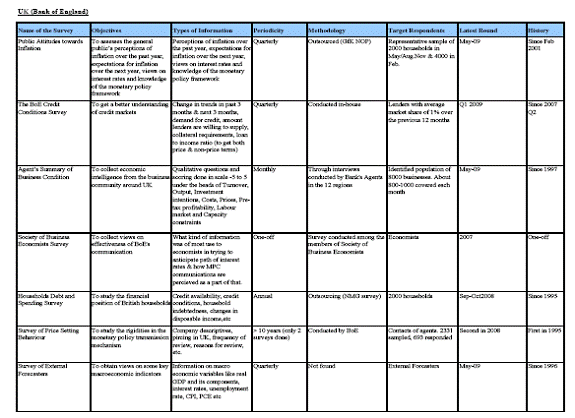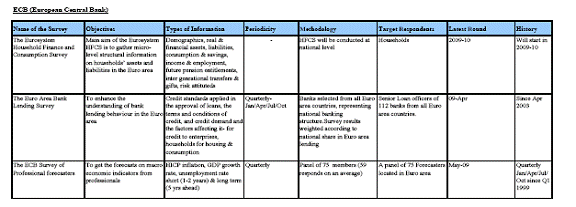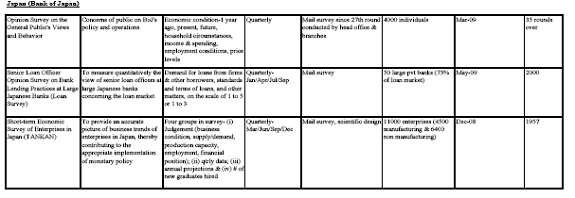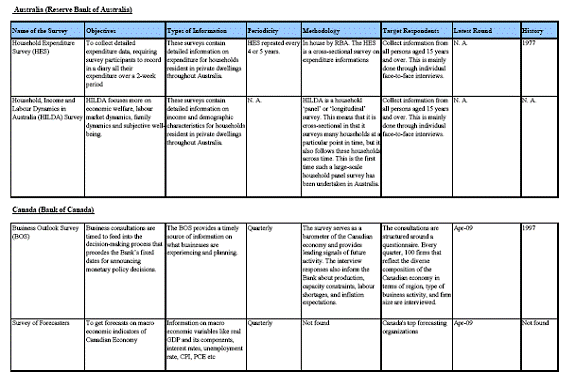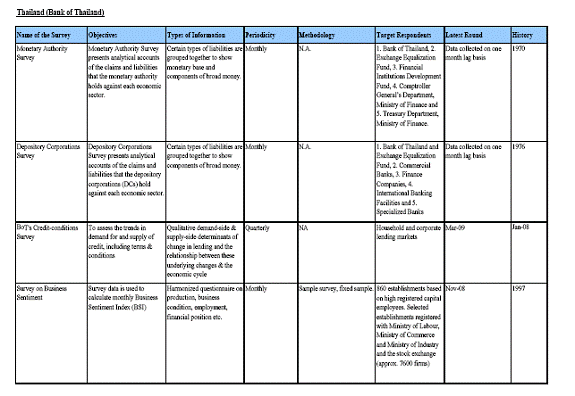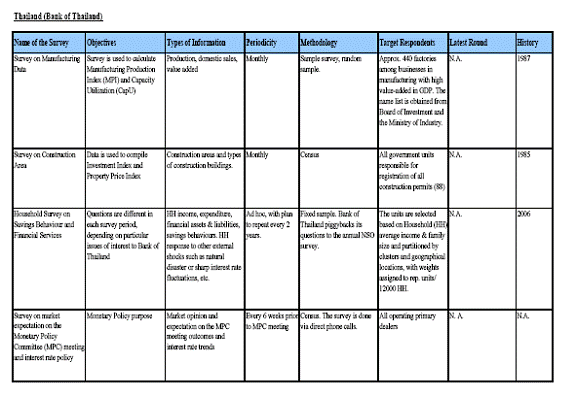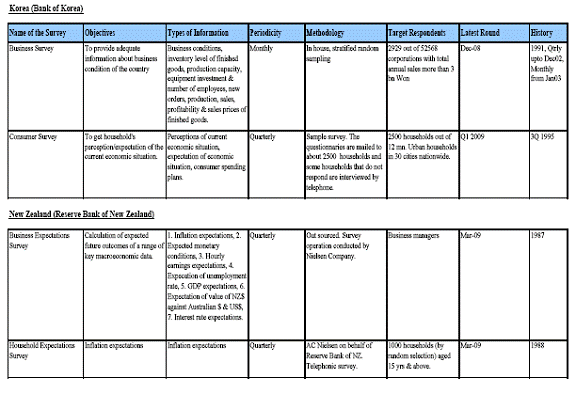Table of Contents
Letter of transmittal
August 25, 2009
Dr. D Subbarao
Governor
Reserve Bank of India
Mumbai
Dear Sir,
Report of the Working Group on Surveys
We are pleased to submit herewith the Report of the Working Group on Surveys constituted by the Reserve Bank of India in December 2008. The report contains a review of the present surveys undertaken by the Reserve Bank and suggestions for carrying out a few new surveys to meet the information need for monetary policy.
Yours faithfully
(Deepak Mohanty)
Chairman
|
(Amal Kanti Ray)
|
(K U B Rao)
|
|
Member
|
Member |
|
(A. B. Chakraborty)
|
(Pardeep Maria)
|
|
Member
|
Member
|
|
(Sanjay Bose)
|
(Sushila Augustine)
|
|
Member
|
Member |
|
(S N S Tyagi)
|
(Praggya Das)
|
|
Member
|
Member Secretary
|
Acknowledgements
On behalf of the Working Group I would like to place on record our gratitude to Dr. Rakesh Mohan, Deputy Governor for appreciating the need to have a comprehensive assessment of the surveys carried out by the Bank.
I thank the members of the Working Group - Dr. Amal Kanti Ray, Shri A.B. Chakraborty, Shri Pardeep Maria, Shri K.U.B Rao, Shri Sanjay Bose, Smt. Sushila Augustine and Shri S.N.S. Tyagi – for their valuable contribution to the deliberations of the Working Group. The Working Group expresses special appreciation for the sincere efforts made by Dr. Praggya Das, Member Secretary in bringing out this report.
The Working Group is also grateful to Shri Bhupal Singh, Shri Deepak Mathur, Shri Supriya Majumdar, Kum. Nilima Ramteke, Shri Abhiman Das for their comments and suggestions. The Group also acknowledges Dr. Seema Saggar and Dr. G.P. Samanta for their analytical inputs on data validation. Shri Avijit Joardar and Smt. Sangeetha Mathews deserve special thanks for providing data analysis and logistical support.
We believe that the recommendation of the Group sets the agenda for survey related work in Reserve Bank to aid policy formulation; besides enhancing transparency and improving timeliness of the existing surveys.
Deepak Mohanty
Chairman
Executive Summary
The Reserve Bank collects and analyses statistics on banking, financial and other economic transactions in the process of conducting monetary policy in India. While a major part of the statistics is collected through either statutory or control returns, information gaps on financial situation and other related areas as well as forward-looking indicators of macroeconomic conditions are met through various surveys.
With globalisation of the economies, greater liberalisation of the domestic financial system and increasingly deregulated markets, need for quick and forward looking information has increased. Given the well known lags in the transmission of monetary policy, the surveys providing macroeconomic outlook attained greater importance. The RBI set up a Working Group on Surveys to review the existing surveys undertaken by the Bank by looking at their objective, methodology, coverage; and relevance, usefulness and validity of the information generated; and to assess the need to conduct more surveys. The major recommendations of the Group are:
A. On existing surveys:
- A one-time article presenting results of the Industrial Outlook Survey should be published in the RBI Bulletin and thereafter such articles should be brought out every quarter.
- As the data quality of the Inflation Expectations Survey has stabilised, the Group recommends that the Technical Advisory Committee on Monetary Policy may consider placing the survey in public domain and suggests that the survey may be extended to the semi-urban or rural centres.
- The Group finds that the scope and coverage of the Survey of Inventories, Order Books and Capacity Utilisation is very comprehensive. The Group recommends that the timeliness of this survey be further improved and the results be placed in public domain.
- To fill the information gap on real estate prices and complement the time-lag and coverage compared to RESIDEX, the Group recommends that the Bank should expedite setting up of the asset price monitoring system.
- Housing Start Index being as an important lead indicator of economic activity, the Group recommends its compilation may be expedited. While the asset price monitoring system will present the price data on housing, the Housing Start Up Index will provide data on the quantity of housing.
- The Group reviewed the surveys carried out by the Bank to compile primary banking sector data, with a specific focus to the Basic Statistical Returns System. The Group feels that the lag in publication of BSR 1 & 2 data is too wide and recommends that all publications based on BSR 1, 2, 4, 5 and 6 should be brought out within the following financial year. The Group also recommends that data on certain variables, like employment that do not come into focus in the current publication, may be published periodically in a separate article in the RBI Bulletin.
- The Small Borrowal Accounts survey is conducted once in two years to obtain a profile and structural pattern of the accounts with credit limit of Rs. 2,00,000 or less. The Group recommends that the time lag in publication of its results should be reduced to nine months of the reference period.
- The Survey of Foreign Collaboration in Indian Industry was instituted by the Reserve Bank of India in 1965 with the objective of collecting comprehensive information on the operations of the Indian companies having foreign collaboration. The Group notes that there is considerable delay in bringing out the survey results and recommends that the survey work may be taken up by DSIM like other surveys.
B. On new surveys:
- The changes in household confidence on economic and personal financial situation, savings and investment intention affect real activities and are of particular relevance for policy purpose. The Group recommends that a consumer confidence survey may be taken up by the RBI using institutional arrangements similar to the Inflation Expectations Survey.
- The Group finds that a regular survey of the credit market conditions would help the RBI to analyse trends and developments in credit growth and terms on which it is provided. It would support analysis of monetary conditions. Gaining from other central banks’ experience, the Group suggests that a credit conditions survey may be conducted on a quarterly basis, covering the large lenders from among the commercial banks.
- The business outlook of private sector provides a sentiment on business confidence before the real data are available. The quarterly Industrial Outlook Survey currently conducted covers only the manufacturing sector. The Group recommends that a business outlook survey for the services sector may be conducted, initially with a focus on trading, as it would provide useful information on the demand for manufactured goods and also the overall employment situation as trading is considered to significantly contribute to employment.
- In the Indian context, a major data gap relates to employment that can be filled by conducting large scale comprehensive surveys by the CSO and NSSO. The Group recommends that to get a perception of trend in employment opportunities, the RBI should consider conducting quick employment surveys of fresh graduates from technical institutions.
- To obtain frequent information on household indebtedness, preferably through triennial surveys of the type of AIDIS, the Group recommends that the Reserve Bank should explore the possibilities with NSSO to conduct thin-sample AIDIS survey.
The monetary policy surveys conducted on a quarterly basis by DSIM have become critical in the light of evolving settings of monetary policy. The Group has recommended a few additional surveys and expansion of scope of existing surveys. This would require additional manpower for DSIM Central Office and its Regional Offices may also need to be further strengthened.
List of Acronyms |
AIDIS |
All India Debt and Investment Survey |
ANOVA |
Analysis of Variance |
ASA |
American Statistical Association |
B-CI |
Bootstrap Confidence Interval |
BEI |
Business Expectation Index |
BER |
Bureau of Economic Research, South Africa |
BHPS |
British Household Panel Survey |
BIS |
Bank for International Settlements |
BOE |
Bank of England |
BoP |
Balance of Payment |
BOS |
Business Outlook Survey |
BSR |
Basic Statistical Returns |
CFSA |
Committee on Financial Sector Assessment |
CPI |
Consumer Price Index |
CPI-IW |
Consumer Price Index for Industrial Workers |
CRISIL |
Credit Rating Information Services of India Ltd. |
CRR |
Cash Reserve Ratio |
CSO |
Central Statistical Organization |
DGET |
Directorate General of Employment and Training |
DRS |
Department of Registration and Stamps |
DSIM |
Department of Statistics and Information Management |
ECB |
European Central Bank |
EMI |
Employment Market Information |
FDI |
Foreign Direct Investment |
GDP |
Gross Domestic Product |
GfK NOP |
A Market Research Company based in London |
HICP |
Harmonised Index of Consumer Prices |
HSUI |
Housing Start Up Index |
IESH |
Inflation Expectation Survey of Households |
IGIDR |
Indira Gandhi Institute of Development Research |
IIP |
Index of Industrial Production |
ISI |
Indian Statistical Institute |
IT |
Information Technology |
JNU |
Jawaharlal Nehru University |
MPD |
Monetary Policy Department |
NBER |
National Bureau of Economic Research |
NBO |
National Building Organization |
NHB |
National Housing Bank |
NORC |
National Organization for Research at the University of Chicago |
NSSO |
National Sample Survey Organization |
OB |
Order Books |
OBS |
Overall Business Situation |
OECD |
Organization for Economic Co-operation& development |
PAT |
Profit after Tax |
PCE |
Personal Consumption Expenditure |
RBNZ |
Reserve Bank of New Zealand |
RGI |
Registrar General of India |
SARB |
South African Reserve Bank |
SBP |
Survey on Building Permits |
SCF |
Survey of Consumer Finances of Federal Reserve |
SHS |
Survey on Housing Starts |
SOF |
Survey of Forecasters |
SPF |
Survey of Professional Forecasters |
TAC on MP |
Technical Advisary Committee on Monetary Policy |
TACS |
Technical Advisary Committee on Surveys |
WPI |
Wholesale Price Index |
WTO |
World Trade Organization |
Section I
Introduction
1.1 Globalisation of the economies, greater liberalisation of the financial system and increasingly deregulated markets, have posed new challenges for the central banks and regulatory authorities in terms of careful monitoring and more prudent regulation of the financial system and overall conduct of policies. In this context, successful implementation of policies needs to be backed by collection of requisite information. It is recognised that with the dismantling of controls and a gradual shift from micro to macro regulation of the financial entities, there has been associated loss of certain information, which could be important from the viewpoint of regulation of the financial system and ensuring financial stability. Beyond this, rapid developments in the financial system characterised by the evolution of new segments and product innovations leads to more dynamic demands for new sets of information for the monetary authorities/regulators of the financial system to keep pace with the fast growing markets. Furthermore, the financial system is now much more interlinked with the real sector of the economy and the developments in the real economy swiftly impact on the balance sheets of the financial entities. There is therefore greater demand for certain forward looking indicators about the behaviour of the real sector entities such as corporates and households, in order to assess the potential risks posed by such exposures. In such situations, monetary and regulatory policies have to be forward looking and the requirements of statistics for helping in reducing uncertainties about the state of the economy increases manifold.
1.2 It is understood that markets operate sub-optimally if there is information asymmetry and structural heterogeneity and the consequent frictions generated in financial markets may render policies inefficient and ineffective. Thus, there is need for precise and timely information on various dimensions of the economy for effective conduct of policies, enhancing market transparency, effective surveillance, safeguarding against short-term shocks and avoiding sub-optimal policy responses. Thus, in a more liberalised and fast evolving financial system, the regulators have to depend on dynamic information, which in an increasingly deregulated environment, could be obtained through alternative modes such as surveys designed to meet such requirements.
1.3
Experience suggests that deregulation must be accompanied by appropriate monitoring systems or surveys to make up for the loss of information due to removal of controls. It is argued by some that the financial crisis that hit the Asian economies was partly occasioned by inadequate data on the activities of the banking system. The current global financial crisis also underlines that in a highly deregulated financial system, lack of information to the regulators of the operations of various entities operating in the financial system, their off-balance sheet exposures specifically in new financial products, could have contributed to the severity of the crisis. Thus, in highly deregulated regimes, conducting surveys becomes an alternative source for obtaining the necessary data for policy input.
I.1 Surveys : Conceptual Aspects
1.4 Studies that involve the systematic collection of data about populations are called surveys. Such studies, which deal with only a fraction of a total population, are called sample surveys. Surveys are many times preferred to complete enumeration as estimates based on an optimal choice of survey design could be more useful than those based on complete enumeration. Sample surveys could yield estimates within a short period, with small margin of error and at a lower cost than complete enumeration. They also offer a greater scope for coverage that may not be feasible in a census, e.g., for certain type of enquiries that require highly trained personnel. It is easier to impart better/uniform training to the investigating staff in the case of surveys.
1.5
A survey may focus on opinions or factual information depending on its purpose, and may involve administering questions to individuals. Statistical techniques can be used to determine validity, reliability, and statistical significance of the findings. Since surveys can be administered from remote locations using mail, email or telephone, large samples are feasible, which help in getting survey results that are statistically robust. Standardized questions about a given topic may lead to more precise measurement by enforcing uniform definitions. With innovations in information technology, electronic surveys are becoming more widely used method of surveys. However, surveys have to be properly designed to serve the objectives.
1.6 Based on the scope of the survey, they can be classified broadly into two types - backward looking and forward looking. In a backward looking survey the objective is to obtain certain information about large groups through a representative fraction when the measurements on entire population cannot be taken for cost, precision or time considerations. Such surveys are usually done to fill data gaps in official statistics. The forward looking surveys, on the other hand, focus on opinion and are conducted to provide inputs for policy purpose and are usually based on qualitative responses to forward looking questions. The surveys conducted by central banks exclusively for monetary policy are usually forward looking and can broadly be identified as an analysis of conjectural developments.
I.2 History of Surveys in the Reserve Bank of India
1.7 The Reserve Bank of India (RBI) collects and analyses statistics on various economic transactions of banking and other financial institutions in the process of the conduct of monetary policy in India. While a major part of the statistics is collected through either statutory or control returns adhering to the international standards and practices that are exclusively used for monetary policy and supervision, information gaps on financial statistics and other related areas are filled up by collecting supplementary statistics through various surveys.
1.8
The first comprehensive survey conducted by RBI was the All-India Rural Credit Survey, with 1951-52 as the reference period. The survey collected information that assisted RBI and the Government of India in formulating an integrated credit policy for rural credit and to assess the extent of indebtedness of rural households to financial institutions in the organized and unorganized sectors.
1.9 As the Indian economy expanded the need for information grew and the Bank adapted and further strengthened its statistical system. It carried out several surveys to collect primary information to fill data gaps. In the External Sector, the Bank has set up a Foreign Exchange Transactions’ Electronic Reporting System and several surveys, like the Unclassified Receipts Survey, Foreign Liabilities & Assets Survey and Coordinated Portfolio Investment Survey, supplemented data of this sector. The RBI also has a Corporate Sector data base that provides information on the functioning of the private corporate business sector, while its Basic Statistical Return (BSR) System collects detailed banking sector data.
1.10
Given the well known lags in the transmission of monetary policy, the surveys providing a macroeconomic outlook attain greater importance. Since the actual data are available with a lag, RBI supplements the information from actual data with forward looking surveys. The RBI has over the past few years, initiated a number of surveys to capture the timely information on the major leading indicators of economic activity. These include the Industrial Outlook Survey; Survey of Inventories, Order Books & Capacity Utilisation; Inflation Expectations Survey of Households and Survey of Professional Forecasters. These surveys have provided extremely useful and timely inputs for the conduct of monetary policy by the Bank.
I.3 Genesis of the Working Group on Survey
1.11 While the timeliness of the information brought out by various surveys is important, it is also equally important to periodically review the methodology, coverage, objective relevance and usefulness of surveys being conducted regularly and ascertain the need of new surveys, more so when the economic climate is rapidly changing.
1.12 Given these perspectives, it was considered necessary to form a Working Group on Survey to examine the surveys being conducted by the RBI and assess the need of new surveys after reviewing the international best practices. Accordingly, the Reserve Bank of India has constituted a Working Group on December 24, 2008.
1.13
The Terms of Reference of the Group are:
(a) to assess information requirement through surveys for monetary policy formulation in the light of international experience;
(b)to carry out a review of surveys conducted by the Department of Statistics and Information Management , particularly the progress of newly instituted surveys;
(c)
to suggest ways to make the survey more forward looking and improve timeliness;
(d)
to assess the need for additional surveys; and
(e)
to consider any other related matter.
1.14 The constitution of the Technical Advisory Group was as follows:
Shri Deepak Mohanty, Executive Director |
Chairman |
Dr. Amal Kanti Ray, O-in-C, DSIM |
Member |
Shri K.U.B. Rao, Adviser, DEAP |
Member |
Shri A.B. Chakraborty, Adviser, MPD |
Member |
Shri Pardeep Maria, Adviser, DSIM |
Member |
Shri Sanjoy Bose, Director, SAD, DSIM |
Member |
Smt. Sushila Augustine, Director, DSIM |
Member |
Shri S.N.S. Tyagi, Assistant Adviser , DSIM, New Delhi |
Member |
Dr. Praggya Das, Assistant Adviser, DSIM |
Member Secretary |
I.4 Report Outline
1.15 The Group deliberated on various issues related to the importance of surveys, and the vital role played by the current RBI surveys in providing inputs for monetary policy. It was also discussed to explore the improvement of current surveys by expanding coverage and scope and the need/possibility to include more surveys by utilizing, inter alia, the experience of other central banks. It was felt necessary to reassess current surveys for policy purpose, such as the Inflation Expectations Survey, to see how survey findings compare with real data, locate mismatches and find reasons for the same. It was also felt important to review the experience with outsourcing of the surveys. Based on these deliberations the report is finalized.
1.16 The Report is organised in four sections. Section II gives a brief review of surveys conducted by select central banks. These surveys are presented under four heads, viz., surveys on monetary and financial conditions, surveys of the corporate sector, surveys of household sector, and surveys on consumer finance/confidence.
1.17
Section III examines the current surveys conducted by the Reserve Bank. For each survey, the objective, scope and coverage, and technical analysis of survey data is given with a special focus on surveys for monetary policy. This is followed by the details on a few surveys that are in progress. A review of the surveys required to fill in data gaps is presented separately for the banking sector and external sector. In the end a short review of the ad hoc surveys is given.
1.18 Finally, Section IV presents the summary of findings and the recommendations of the Working Group.
1.19
The Secretariat of the Group was located in the Survey Division, Department of Statistics and Information Management. The Secretariat in addition to carrying out review of various surveys also carried out validation exercises for the present monetary policy surveys to assess the quality of its estimates vis-à-vis the actual data that is obtained subsequently. The findings of such exercises are presented in the Report.
Section II
Surveys Conducted by Select Central Banks
2.1 Most central banks make extensive use of surveys alongside the official data in order to form an up-to-date and reliable picture of the current state of economy. With a view to drawing lessons from international experience, the Group carried out a review of the surveys conducted by select central banks. An analytical review of the country practices in regard to the surveys conducted by United States of America, United Kingdom, Europe (European Central Bank), Japan, Australia, Canada, Thailand, Korea and New Zealand is given in Annex 2. The details include the objective of the survey, the type of information collected, methodology, periodicity and history. The key surveys of select countries are summarised below under the heads of surveys conducted for assessing monetary and financial conditions, surveys of the corporate sector, surveys of the household sector and surveys on consumer finance/confidence.
II.1 Surveys on Monetary and Financial Conditions
2.2 Central banks traditionally collect information on monetary and financial conditions through censuses of banks. The development of new types of financial institutions, instruments and markets have generated new data requirements for central banks. New types of data collection techniques have therefore been adopted, including cut-off-the-tail reporting as well as fixed and random sampling. The new techniques allow central banks to interpolate monetary and financial conditions from samples to a broader population.
2.3 The Bank of England (BoE) Credit Conditions Survey: The BoE’s surveillance and market intelligence functions endeavours to meet its objective of identifying, assessing and reducing threats to the financial system as a whole. In order to improve its understanding of credit markets, the Bank conducts a quarterly Credit Conditions Survey with support from the lenders and market participants. The questions relate to changes over the past three months relative to the previous three months and over the next three months relative to the latest three months. The survey is voluntary and is intended to assess trends in the demand for, and the supply of credit, including terms and conditions. It covers both household and corporate lending markets.
2.4 Senior Loan Officer Opinion Survey on Bank Lending Practices in the US: The Fed Reserve Board conducts the Senior Loan Officer Opinion Survey on Bank Lending Practicesof approximately sixty large domestic banks and twenty-four US branches and agencies of foreign banks. Questions cover changes in the standards and terms of the banks' lending and the state of business and household demand for loans. Often the survey includes questions on one or two other topics of current interest. The Federal Reserve generally conducts the survey quarterly, timing it so that results are available for the January/February, April/May, August, and October/November meetings of the Federal Open Market Committee.
2.5 The Euro Area Bank Lending Survey: The bank lending survey is addressed to senior loan officers at a representative sample (112 banks) of euro area banks. Its main purpose is to enhance the understanding of bank lending behaviour in the euro area. The questions distinguish between three categories of loan: loans or credit lines to enterprises; loans to households for house purchase; and consumer credit and other lending to households. For all three categories, questions are asked regarding credit standards applied in the approval of loans; the terms and conditions of credit; and credit demand and the factors affecting it. The responses to questions related to credit standards are analysed on the ‘net difference’ between the share of banks reporting that credit standards have been tightened and those reporting that they have been eased. A positive (negative) net difference indicates that a larger proportion of banks have tightened (eased) credit standards. The survey questions are phrased in terms of changes over the past three months or expectations of changes over the next three months.
2.6 Survey of Professional Forecasters: The Survey of Professional Forecasters has a long tradition. The American Statistical Association (ASA), together with National Bureau of Economic Research (NBER) began conducting the survey (later came to be called the ASA/NBER Economic Outlook Survey) in the fourth quarter of 1968. Due to decline in the number of forecasters, the survey was discontinued and was later revived by the Federal Reserve Bank of Philadelphia with some modifications in second quarter of 1990 as 'Survey of Professional Forecasters'. Forecasts are available for a large assortment of macroeconomic variables, including real gross domestic product (GDP) and its components, interest rates, the unemployment rate, two price index series, viz. Consumer Price Index (CPI) & Personal Consumption Expenditure (PCE), and various other business indicators. Each survey includes quarterly forecasts for the current and following four quarters as well as annual forecasts for the current and following year.
2.7 The European Central Bank (ECB) started conducting a survey of macroeconomic expectations, also known as the Survey of Professional Forecasters (SPF), in the euro area in early 1999. The SPF questionnaire includes questions on expectations for Harmonised Index of Consumer Prices (HICP) inflation, the real GDP growth rate, and the unemployment rate in the euro area over different horizons, as well as questions seeking to quantify the uncertainty surrounding these variables. The ECB’s SPF is conducted four times a year, with the survey rounds taking place in the first month of each quarter. The survey results are published in the ECB’s Monthly Bulletin. ‘The ECB Survey of Professional Forecasters (SPF) – A Review After Eight Years Experience’ reveals that SPF panel members, like most other forecasters, have tended to under-predict euro area inflation1. However, a large part of this error can be explained by the sequence of asymmetric and largely unpredictable shocks that hit euro area inflation over the period viz., oil prices, weather related food shocks and indirect taxes.
2.8
The Bank of England since 1996 carries out Survey of External Forecasters every quarter for obtaining views on some key macroeconomic indicators and provides useful information on expectations outside the bank about future economic developments. The survey is carried out just before the quarterly ‘Inflation Report’ and a summary of the results is reported in a box. A detailed analysis of the survey results is placed before the members of the monetary policy committee.
2.9 he Conference Board of Canada carries out the Survey of Forecasters (SOF) every quarter reflecting the opinions of Canada's top forecasting organizations on their outlook for the Canadian economy. The Reserve Bank of New Zealand (RBNZ) conducts Survey of Expectations, a New Zealand-wide quarterly survey of business managers. ACNielsen, a private company conducts the survey on the RBNZ's behalf in which respondents are asked for their expectations of future outcomes of a range of key economic data, like inflation expectations, expected monetary conditions, hourly earnings expectations, expectations of unemployment rate, GDP expectations, etc.
II.2 Surveys of Corporate Sector
2.10 The non-financial corporate sector is one of the key sectors in a market economy. It produces the tradable and non-tradable goods and services demanded by the household sector and the rest of the world and offers most of the employment opportunities in the country. The major source of statistical information on this sector comes from the national and financial accounts. Even though considerable efforts are being made to improve national accounts data, in terms of coverage and timeliness, the information that is published is backward-looking. Policy makers want to have more timely data as well as indicators of business sentiment that may be driving business decisions and conditions now or in the foreseeable future. For that reason statistical agencies have developed other tools that permit a closer monitoring of this sector. In many countries central banks play an important role in this area as most of the central banks carry out a survey of the corporate sector of some kind. This includes the conduct of business confidence or sentiment surveys and the collection of corporate balance-sheet data.
2.11
The business surveys provide up-to-date qualitative indicators and can be used to gain insight into the economic climate before official national account or industrial production statistics are published. Such surveys have a history dating from at least 1920s. Some of the earliest surveys were carried out by trade associations, such as the Confederation of British Industries and the ifo Institut für Wirtschaftsforschung in Germany.
2.12 Central banks in many countries have also been carrying out business tendency surveys for some years. The Organisation for Economic Co-operation and Development (OECD) has set out guidelines in 2003 called ‘Business Tendency Surveys: A Handbook’ to promote international standards in the development of business tendency surveys.
2.13
Some of the early surveys covered enterprises engaged in different kinds of activities, and this is still the case with most of the surveys carried out in Asia and Latin America. However, lately there is a trend towards activity-specific surveys using questionnaires and sample selection tailored to the particular characteristics of different activities. This is the recommendation of the OECD Handbook as well and the annexes to the Handbook contain separate questionnaires for use in manufacturing, trade, construction and other services.
2.14 Business surveys are generally carried out using a similar methodology. A short list of questions reflecting current conditions or forward-looking is posed to representatives of the business sector. Variables include sales, exports, price movements, order books, capacity utilisation, employment, etc.
2.15
In most business tendency surveys, respondents have three reply options such as up, same, down; or above normal, normal, below normal; or increase, remain same, decrease. Because of the difficulty of interpreting all three percentages, business tendency survey results are normally converted into a single quantitative number. The two most common ways of doing this are to use “Balances” (also called “Net-Balances”) or “Diffusion Indices” 2. Net Balances can take values from –100 to +100, while diffusion indices range from 0 to 100. The midpoints are, respectively, 0 and 50. Both indices move in the same way over time but, because the range for diffusion indices is narrower than for balances, diffusion indices are flatter than balances when shown in graphical form. In practice, Net Balances are the commonest way of presenting the results of business tendency surveys and the OECD Handbook deals only with Net Balances. Some of the prominent business confidence surveys conducted by different central banks are:
2.16 Agent’s Summary of Business Condition of the Bank of England: Bank's Agents (who are the Bank’s employee) collect economic intelligence from the business community around the United Kingdom. This intelligence is largely qualitative, and provides timely insights into economic conditions and behaviour to supplement the published data. Agents also make quantitative judgements about economic conditions in the form of a series of scores which are computed for turnover, output, investment intentions, costs, prices, pre-tax profitability, labour market and capacity constraints. These scores are published monthly in a statistical annex to the Agents’ Summary of Business Conditions and are one of a range of communication devices for the Agencies to relay observations about economic conditions to the Monetary Policy Committee.
2.17 Business Outlook Survey by Bank of Canada: The Business Outlook Survey provides a timely source of information on what businesses are experiencing and planning. Business consultations are timed to feed into the decision-making process that precedes the Bank’s fixed dates for announcing monetary policy decisions. Every quarter, 100 firms that reflect the diverse composition of the Canadian economy in terms of region, type of business activity, and firm size are interviewed.
2.18 Short-term Economic Survey of Enterprises in Japan (TANKAN): The TANKAN survey provides an accurate picture of business trends of enterprises in Japan, thereby contributing to the appropriate implementation of monetary policy. Four groups of information is sought in the survey (i) Judgement (business condition, supply/demand, production capacity, employment, financial position); (ii) Quarterly data; (iii) Annual projections; and (iv) Number of new graduates hired. This scientifically designed quarterly survey covers 11,000 enterprises.
II.3 Surveys of Household Sector
2.19 Households play an important role in economies and therefore it is important for central banks to understand their behaviour and expectations. More recently, households and financial markets have started to become more dependent upon each other as households attempt to improve the smoothening of their consumption across their lifetime and as financial markets develop services to facilitate this process.
2.20
Central banks need to have access to household sector data that are timely, methodologically consistent, and comprehensive. In many countries central banks have taken initiatives to conduct surveys of the household sector. One reason is to collect information on household sentiments such as with respect to inflation expectations or consumer confidence. Another is to obtain more detailed information on households' financial transactions or positions such as use of payment instruments or household assets and liabilities, including their distribution across income categories. The latter information can assist central banks in examining the effects of possible shocks, such as interest rate increases, on different groups of households.
2.21 In many countries central banks have taken initiatives to conduct surveys of the household sector. For this purpose, many central banks cooperate with the statistical agencies of their country on survey design, coverage, and analysis. Some central banks outsource their household surveys to private or public sector agencies.
2.22 Public Attitudes towards Inflation of the Bank of England: The BoE believes that its monetary policy framework will be most effective if it is accompanied by wide public understanding and support, both for the objective of price stability and for the methods used to achieve it. The Bank of England’s survey assesses the general public’s perceptions of inflation over the past year, expectations for inflation over the next year, views on interest rates and knowledge of the monetary policy framework. The survey is conducted quarterly, by a market research agency called GfK NOP, of adults aged 16 years and over every February, May, August and November, and usually samples around 2,000 individuals. The February survey is more comprehensive, comprising a longer list of questions and a sample size of around 4000 people.
2.23 Household Inflation Expectation of the Reserve Bank of New Zealand: The Reserve Bank of New Zealand contracts a survey company to ask respondents three questions relating to inflation expectations. These questions are (i) perception of current inflation; (ii) expectation of future rise or fall in inflation; and iii) expectation of the inflation rate in one year’s time. The survey that consisted of 1000 people aged 15 years and over till December 2008, now covers the telephone survey of 750 people aged 18 years and over.
II .4 Surveys on Consumer finance/confidence
2.24 Opinion Survey on the General Public's Views and Behaviour: The Bank of Japan has been seeking to determine the concerns of a broad cross-section of the general public related to its policy and operations on economic condition; household circumstances; income & spending, employment conditions and price levels. The Bank's Opinion Survey is being conducted since 1993 with a nationwide sample of 4,000 individuals who are at least 20 years of age. This survey is essentially an opinion poll designed to gain insight into the public's perceptions and actions. A mail survey method was introduced from the 27th Opinion Survey. Earlier the researchers visited sampled individuals, asked them to complete the questionnaire within a prescribed period, and then collected the finished questionnaires upon subsequent visits.
2.25 Survey of Consumer Finances of Federal Reserve: The Survey of Consumer Finances (SCF) is conducted to provide detailed information on the finances of U.S. families. No other study for the country collects comparable information. Data from the SCF are widely used, from analysis at the Federal Reserve and other branches of government to scholarly work at the major economic research centres. SCF is a triennial survey of the balance sheet, pension, income, and other demographic characteristics of U.S. families. The survey also gathers information on the extent of use of various financial institutions by the borrowers. The study is sponsored by the Federal Reserve Board in cooperation with the Department of the Treasury. Since 1992, data have been collected by the National Organization for Research at the University of Chicago (NORC). To ensure the representativeness of the study, respondents are selected randomly with an attempt to select families from all economic strata.
2.26 Household Debt and Spending Survey of Bank of England: A key question for monetary policy makers in many countries is whether the build-up of household debt in recent years has affected the way in which households respond to changes in interest rates and economic conditions more generally. The Bank of England carried out the latest round of this survey (fifth in the series) in September 2007 in which a representative sample of around 2000 people were asked a range of questions about their finances. These included questions about how much debt households owed; whether their borrowing was secured or unsecured; whether they found it to be a burden; and whether they had experienced difficulty accessing further credit. The 2007 survey included additional questions on how much mortgage payments had increased and how the households affected by this had financed their extra outgoings. Taken together with information from successive waves of the British Household Panel Survey (BHPS), the survey sheds light on trends in the financial position of British households since 1991, the first wave of the BHPS. The survey is annual.
Section III
Surveys Conducted by Reserve Bank of India
3.1 The surveys conducted by the RBI can be broadly classified into four categories. First, the monetary policy surveys including (i) industrial outlook survey, (ii) inflation expectations survey for households, (iii) survey of professional forecasters and (iv) survey of inventories, order books and capacity utilization. Second, the banking sector including (i) survey on distribution of credit, deposits and employment in banks (Basic Statistical Return (BSR) 1 & 2), (ii) survey on advances against sensitive commodities (BSR 3), (iii) survey on composition and ownership of deposits with scheduled commercial banks (BSR 4), (iv) survey on investment portfolio of scheduled commercial banks (BSR 5), (v) survey of debits to deposit accounts with scheduled commercial banks (BSR 6), (vi) survey on international assets and liabilities of banks, (vii) co-ordinated portfolio investment survey for commercial banks and (viii) survey of small borrowal accounts. Third, the external sector including (i) survey of foreign liabilities and assets for corporate, insurance & mutual fund sectors, (ii) coordinated portfolio investment survey for corporate, insurance & mutual fund sectors, (iii) survey on software and IT services export, (iv) unclassified receipt survey used for BoP, (v) survey on balances in Nostro / Vostro account used in BoP, (vi) survey on non-resident deposits, (vii) international trade in banking services, (viii) survey on private remittances to India, (ix) survey on freight and insurance component in Indian exports and (x) survey of foreign collaboration in Indian industry. Fourth, the ad hoc surveys which include (i) the census of non-banking financial companies not accepting public deposits, (ii) review of payment and settlement survey and (iii) various types of customer satisfaction surveys. The details about these surveys conducted by the RBI are given in Annex 1.
III.1 Surveys for Monetary Policy purpose
Industrial Outlook Survey
3.2 Business outlook surveys that are also known as business tendency, business opinion or business climate surveys are carried out to obtain qualitativeinformation for use in monitoring the current business situation and forecasting short-term developments. These surveys ask company managers about the current status of their business and about their plans and expectations for the near future. The surveys of this type provide information that is valuable to the respondents themselves and to economic policy makers and analysts. Although they do not provide precise information on levels of output, sales, investment or employment they can be used to predict changes in these aggregates and, for that reason, they are particularly useful for analysing the business cycle.
3.3 Objective: The Reserve Bank of India has been conducting Industrial Outlook Surveys, since 1998, on a quarterly basis with a view to gain insight into the performance and prospects of the private corporate sector engaged in manufacturing activities. The survey presents an advance assessment on economic and industrial environment based on the qualitative data collected from the public and private limited manufacturing companies in the private sector. The contents of the questionnaire are placed in Annex 3.
3.4 Scope and coverage: The survey covers the non-government non-financial private and public limited companies engaged in manufacturing. The survey design is purposive and the companies are selected to get a good representation of size and industry. The scope of the survey is restricted to seeking qualitative responses on indicators of demand, financial situation, price and employment expectations, etc.
3.5 Reference period: The reference period for the quarterly industrial outlook survey is the survey quarter for the assessment of business sentiments and its expectation for the ensuing quarter.
3.6 Technical analysis of survey data: The Working Group carried out technical analysis of the survey data to examine the results obtained from the survey on key indicators with the corresponding actual official statistics that is released subsequently. The Graphs 2.1 and 2.2 show the movement of the Business Expectation Indices with the movements in GDP manufacturing and IIP manufacturing and the price expectations from the survey with the WPI manufacturing inflation, respectively. It can be seen that the survey indicators provide good leading information about the movements in these key macroeconomic aggregates released subsequently.
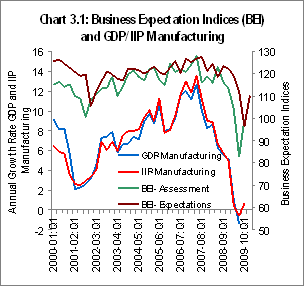
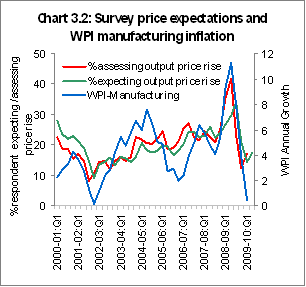
3.7 The Group also examined how closely ‘assessment’ and ‘expectation’ in the quarterly Industrial Outlook Survey track the observed quarterly movement in various indicators of corporate performance. The empirical exercise employed information on survey responses (Business Expectation Indices as well as select individual parameters/question, such as, overall business situation, order books, production and profit margin) and observed corporate/industrial performance (in terms of select indicators like, IIP, sales, gross profits, net profits and profit margin). The results show that BEI-assessment captures turning points in IIP growth well. So was the case for gross profits and net profits/profits after tax (PAT). When it comes to overall relationship, regression results show that BEI-assessment has strong correlation with growth in IIP as well as other performance indicators. The findings for BEI-expectation are broadly similar to those of BEI-assessment, except that the former has weak correlation with changes in PAT.
3.8
Analyses using select survey indicators also show that both assessment and expectation on Overall Business Situation (OBS) as well as Order Books (OB) capture the turning points in IIP and other performance indicators well with the exception of directional changes in sales. Survey responses in terms of assessment and expectation on 'production' captured major turning points in IIP growth well, and both survey indicators are strongly correlated with later. However, responses on 'profit margin' are neither correlated with nor able to capture major turns in observed profit margin well. The details of the findings are presented in Annex 4.
3.9 In light of the empirical analysis of the results of the Industrial Outlook Survey, the Group feels that the objective, scope and coverage meet the present purpose and the findings from the survey provide useful forward looking inputs for monetary policy. However, as of now, only a highlight of the survey findings are available in public domain that is released through the quarterly publication Macroeconomic and Monetary Developments. The Group recommends that the detailed results of the Industrial Outlook Survey should be placed in public domain. A one-time article on the time series of results should be published in the RBI Bulletin and thereafter every quarter the findings should be released through the Bank’s website and a Bulletin article.
Inflation Expectations Survey of Households
3.10 Survey measures of inflation expectations are important to policy makers and researchers because they provide data on an otherwise unobservable variable. Measures of inflation expectations are important to central banks as they have the sole responsibility to ensure price stability. Expectations of inflation can influence the linkage between money, interest rates, and prices. Many household and business decisions depend on the inflation expectations of market participants. First, inflation expectations are important for wage negotiations. Second, inflation expectations play a key role in households’ saving decisions. For a given level of nominal interest rates, higher expected inflation implies a lower expected real rate of return on saving. That would tend to make spending today more attractive relative to saving. Finally, businesses need to make a judgement on the likely path of the prices of other goods that they may be competing with, so that they can judge the likely demand for their product. If they expect the prices of other goods to be higher, that may prompt them to raise their own output prices (Benford and Driver, 2008)3. Thus arriving at a measure of inflation expectation attains importance for policy makers.
3.11 Objective: Keeping in view the importance of inflation expectations as an input for monetary policy, the price and inflation expectations of households are being captured by RBI through its quarterly Inflation Expectations Survey of Households (IESH) since September 2005. The survey presents a measure of households’ present perception of inflation as well as its expectations for the near future. The households’ inflation expectations are distinctly different from the inflation measures available through the official price indices as the basket of consumption of the survey participants varies as per their requirement and perception.
3.12 Scope and coverage: The survey covers 4,000 households using quota sampling, across 12 cities across the four regions of the country. The survey design is purposive and the respondents are chosen so as to get a good geographical representation of the city and a fine mix of gender, age and employment status of households. The scope of the survey centres on seeking (i) qualitative responses on price changes (general prices as well as prices of specific product groups) in next three months and next one year and (ii) quantitative responses on current, three month ahead and one year ahead inflation rates. The first two rounds of the survey were conducted in four metros only and covered 2,000 households. Third round onwards, the scope and coverage of the survey was enhanced to cover 4,000 respondents in 12 cities including the four metros. The contents of the survey schedule are placed in Annex 5.
3.13 Reference period: The reference period for the inflation expectations survey of households is the current quarter, the next quarter and the next year.
3.14 Technical analysis of survey data: A Technical Advisory Committee for Surveys (TACS) was set up during the year 2007 to examine the consistency and reliability of the survey data. There were internal inconsistencies that existed in the initial rounds of the survey data for which, as suggested by the TACS, the Reserve Bank took up training of investigators before launch of each round of survey and carried out stringent field check with the involvement of its regional offices. The TACS has since examined the IESH data to assess its quality and internal consistency. The analysis shows that the survey results have shown improvement from the twelfth round onwards. The inconsistency has reduced both within qualitative block and between the qualitative and quantitative blocks. An analysis of variance was carried out to see which factor (gender, age, category or city) is responsible for causing variability in the responses of the households. The analysis revealed that city is the largest source of variation which is logically appealing as the consumption pattern varies across cities. It is also reflected through the large inter-city variations in the official price indices. To assess the quality of the estimates of households’ inflation expectations generated through the survey, confidence intervals were worked out using bootstrap resampling plan. Table 2.1 shows that confidence intervals are narrow of around 20 to 30 basis points. The size of the confidence intervals increases with the time horizon, indicating that the respondents are more coherent on their perception of the current inflation than their expectation of near future. Details of the analysis are presented in Annex 6.
 3.15 There are ample studies comparing households’ inflation forecasts with those of economic forecasters or with official numbers. In one such study, Bryan and Gavin (1986)4 examined the inflation forecasts from two surveys: one taken from households (Michigan survey), and the other taken from professional economists (Livingston survey). The study revealed that though none of the forecasts performed well in an absolute sense, the Michigan survey of households was more accurate and less biased than the Livingston survey. Among the possible reason was that the large sample of households is relatively more representative of the participants in the market for the basket of goods covered by the Consumer Price Index. No individual actually buys the representative basket of goods; the basket will vary with demographics and income class. A small, homogeneous group of consumers would misforecast the inflation rate as badly as do economists. Thus the authors concluded that for those users who need an observable measure of inflation expectations, the Michigan survey of households is more likely to represent the expectations of rational, maximising agents, than is the extensively used Livingston survey of economists.
3.16
The analysis of the Inflation Expectations Survey data shows that internal consistency of the responses that was initially a concern, has now been achieved. The short survey schedule that is used for the survey is adequate to meet its scope. The Group feels that in the context of improving monetary policy transparency, various indicators related to inflation and inflation expectations considered by the Reserve Bank may be made available to the market. The Group recommends that since the inflation expectations survey has stabilised, TAC on Monetary Policy may consider placing the survey in public domain. Presently the survey is limited to households from metro or large cities. The consumption and price patterns are known to vary across different centres of the country and the survey does not capture the inflation expectations of the households in the semi-urban and rural areas. The Group feels that the survey may be extended to include households from the semi-urban or rural centres.
Survey of Professional Forecasters
3.17 Objective: Economic forecasting is a pre-requisite for a forward-looking macroeconomic policy. Forecasts of key macroeconomic indicators, such as output growth, inflation and interest rates are important not only for the Central Bank, but also for the Government, private businesses and individual households.5 In this context, recent evidence suggests that while there are various methods of forecasting, survey forecasts outperform other forecasting methods (Ang et al., 2005)6. Traditional discussions of the theory of forecasting assume that professional forecasters attempt to minimize their forecast errors by using their training, expertise, and experience. In this respect, 'Survey of Professional Forecasters' (SPF) is conducted by several central banks on major macroeconomic indicators of short to medium term economic
developments as they can signal future risks to price stability and growth, and provide information on how economic agents gauge their risks.
3.18 Scope and coverage: The design of SPF is purposive and covers forecasters that have an established research set-up and bring out periodic updates on economic developments. These organizations include investment banks, commercial banks, stock exchanges, international brokerage houses, select educational institutions, credit rating agencies, securities firms, asset management companies, etc. The schedule covers annual as well as quarterly forecasts of major macroeconomic variables such as, Real GDP, M3, Bank Credit, Corporate profit, Repo, Reverse Repo, CRR, Government Securities, Balance of Payments, WPI, CPI-IW. The probabilities attached to possible outcomes of GDP and WPI are asked as well as their long term forecasts. The contents of the questionnaire are detailed in Annex 7.
3.19 Reference period: The survey seeks annual as well as quarterly forecasts for major macro economic variables. It also seeks long term forecasts over 5 to 10 years for output and prices.
3.20 Dissemination of results: The results of the survey are presented to the top management in Monetary Policy Strategy meeting and are placed on RBI website for public dissemination with appropriate disclaimer. Salient features of the survey are included in quarterly Macroeconomic and Monetary Developments.
3.21 Technical analysis of the survey data: The Group examined the data generated from the survey of professional forecasters. Since the survey is new and data is available for very few time points, only broad assessment could be made. The analysis shows that the GDP forecasts were closer to actual whereas the inflation forecasts were not (Annex 8). A better assessment of the survey results could be made in due course with a longer time series.
3.22
The Survey of Professional Forecasters is a new survey and a detailed analysis of the validity of its results was constrained by the short length of series generated by it. However, literature review shows that such surveys are conducted by several central banks and recent evidences also suggest that while there are various methods of forecasting, survey forecasts outperform other forecasting methods. The Group feels that the results of Bank’s Survey of Professional Forecasters provide useful inputs every quarter for a broad range of economic indicators. Once the survey series attain a longer length, the Group recommends that the Bank should carry out validity of its results. The Group suggests that if there are some forecasters whose response is perpetually an outlier; the same may be dropped from the survey. The results of the survey are already in public domain and the Group suggest continuation of the same in the present form
Survey of Inventories, Order Books and Capacity Utilization
3.23 The movements in inventories, order books and capacity utilisation are important indicators of economic activity, inflation and overall business cycle. The inventory and order book levels indicate changes in demand and if the market demand grows (weakens), capacity utilisation will rise (slacken). If capacity utilisation is above certain level, inflationary pressures would be higher, while excess capacity means that insufficient demand and hence lower inflation. Thus, capacity utilisation levels indicate whether the production conditions are slack or tight and whether restrictive or expansionary macroeconomic policies would be useful. Behaviour of inventories, order books and capacity utilisation levels can be used to assess the future investment demand that tends to vary directly with increase in capacity utilization.
3.24 Objective: The Bank launched the quarterly Survey of Inventories, Order Books and Capacity Utilisation in April 2007 with an objective of providing the most recent data (yearly and quarterly) at the industry level on the various important business cycle indicators.
3.25 Scope and coverage: The survey covers the public and private corporate sector with about 1,500 companies as participants. The survey design is purposive and the companies are selected so as to get a good mix of size and industries. The scope of the survey includes seeking quarterly data on balance sheet items like paid-up capital, sales, total assets/liabilities, inventories (separately for finished goods and work-in progress), order books (backlog orders, new orders, export orders and pending orders) and also detailed product-wise information on installed capacity, quantity produced in the units of production. The contents of the survey are given in Annex 9.
3.26 Reference period: The Survey data pertains to the business of reference quarter and is collected in the following quarter. Thus the reference period of the survey is the preceding quarter. The first quarter of data pertains to December 2006.
3.27 Technical analysis of survey data: The survey is of recent origin and though the time lag in data receipt has been significantly reduced, it is yet to reduce to a quarter. The data quality of the survey is under close scrutiny and both timeliness as well as quality are getting stabilised. It took time for the agency that is collecting the data on behalf of the Bank to build a rapport with the participating companies. The Group compared the capacity utilisation numbers of the latest four quarters with the growth rate of IIP and GDP manufacturing of the corresponding quarters and found close co-movements of these indicators. As the time series of the survey grows, detailed validation exercises with other performance indicators could be carried out.
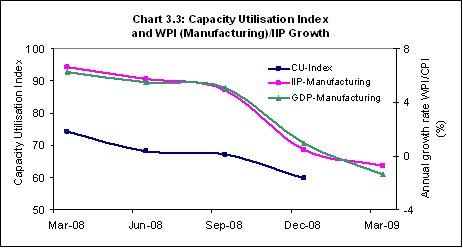 3.28 The Group feels that the scope and coverage of the Survey of Inventories, Order Books and Capacity Utilisation is very comprehensive. It recognises the difficulties faced by the RBI in stabilising a survey that calls for detailed quarterly information at product level from companies through a voluntary return. The Group is appreciative of the efforts put in for improving its timeliness and quality. An empirical assessment shows that the recent rounds of data are yielding results that closely track the movements in the official series, however, with a short series, more involved analysis could not be carried out. The Group feels that in view of the importance of these data as an input for policy, timeliness should be given high priority. The Group, therefore, recommends that while it is desirable to keep a close scrutiny on data quality, strict timeliness should be adhered and the quarterly survey findings should be made available for that quarter’s monetary policy review. Once the survey stabilises, the Group suggests that the survey results should be placed in the public domain.
III.2 The Surveys in Progress
Asset Price Monitoring System
3.29 Changes in asset prices influence household wealth and therefore impact consumer spending and aggregate demand. Asset prices also contain important information about the current and future state of the economy and play an important role in monetary policy setting. International organizations like the Bank for International Settlements (BIS) and the European Central Bank (ECB), government agencies in several developing and industrial countries, and private sector companies in some countries have been compiling indices at the regional and national levels to measure developments in real estate or other segments of asset markets. In absence of any comprehensive information system for India, the National Housing Bank (NHB), at the behest of Ministry of Finance, launched NHB RESIDEX for tracking prices of residential properties in July 2007 with 2001 taken as the base year. Based on the data from housing finance companies along with data arranged by NCAER, updated RESIDEX is now available up to December 2008. NHB’s data base, however, does not cover commercial properties. Another limitation is that though RESIDEX is very broad based, it is available with half-yearly frequency with a time-lag. However, by tapping the vast data lying within the banking system as also with Department of Registration and Stamps (DRS) across the States one can obtain a rapid estimate about the current trend and direction of house prices on a quarterly basis.
3.30 Objective: With a view to capture the current trend on real estate prices and rent covering both the residential and commercial properties, it was thought imperative to establish an appropriate statistical system within RBI so as to access as well as analyse the different sources of primary data on house prices and rent. An expert group on Asset Price Monitoring System has, therefore, been set up in the RBI to standardise and formulate suitable methodology for data collection, price index compilation and analysis of asset prices. The group has membership from NHB, ICICI, IGIDR, ISI, CSO, HDFC Realty and State Bank of India. The group is expected to suggest method for establishing a system of real estate price data collection and will recommend an appropriate survey format for data collection.
3.31 Scope and coverage: The asset price monitoring system is expected to cover the entire gamut of real estate price movements including sale/resale/rent of residential/commercial property of representative locations across the country. The system would cover all the leading banks having significant presence in the housing loan segment. The data is intended to be sourced centrally from the IT departments of banks on three parameters, viz., location, area and transaction price of the property on a quarterly basis. An additional validation survey would be conducted annually by taking out a sample from the data collected quarterly and contacting the property agents to check the robustness of the bank data. The data on rent will be obtained by the Central Statistical Organisation.
3.32 Reference period: The periodicity of compiling Asset Price Index would be quarterly to synchronise with monetary policy and the reference period will be the current survey quarter.
3.33 Technical work done in this area so far: As per the latest update of NHB RESIDEX on residential price movements in India, price movement data are now available on a six monthly basis. The details on construction of RESIDEX are given in Annex 10. The currently available data on RESIDEX for 15 cities portray the following pattern:
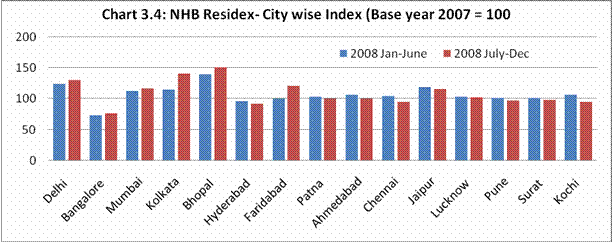 3.34 Another initiative was taken up by the Bank to study the house price movement in Mumbai, where the price data on transacted houses were collected from the Department of Registration and Stamps (DRS), Government of Maharashtra. The Bank’s study was based on the officially declared prices by buyers, covering about 3,00,000 official transactions collected from DRS, Government of Maharashtra. Based on these data, a quarterly index was constructed till Q2 of 2007-08 (2002-03 as the base year). Based on the further data from DRS (Maharashtra) for October 2007 – May 2009, similar exercise till Q1: 2009-10 is in progress.
3.35
From the sectoral deployment of credit, it is evident that the growth of housing loans in past few years in India has been phenomenal and therefore the importance of this sector for banks has increased significantly. The Group sees that in spite of several efforts towards building information on real estate prices, large data gaps exist. The Group feels that the information base in this sector is not sufficiently well developed. The endeavours to fill the gap for monetary policy requirement based on data accessed from the banking system would complement the time -lag and frequency of data updation compared to RESIDEX as also data coverage by way of covering commercial properties and rent on housing properties. In view of this the Group recommends that the Bank should expedite the setting up of the asset price monitoring system to have comprehensive information on real estate prices.
Housing Start-up Index
3.36 Housing start is considered an important leading indicator of economic activity, given its strong and substantial forward and backward linkages with other sectors of the economy. In particular, information on trends in number of new houses being started can provide useful information on the likely pace of economic activity over a horizon that is of importance to the monetary policy. An increase in the number of houses getting started, measured through Housing Start Up Index (HSUI), would be indicative of an increase in investment, business and consumer optimism and vice versa. Given the limited available data in regard to housing indicators on one hand and the Bank’s efforts to expand database in regard to leading indicators on the other hand, it is considered desirable to develop a HSUI for India. Accordingly, the Reserve Bank of India constituted a Technical Advisory Group for "Development of Housing Start-up Index" in July 2007. The major recommendations of the Group on methodology and Institutional arrangements are:
a.
Methodology:
(i)
The present system of data collection by National Building Organization on annual basis can be fine tuned to obtain the requisite data on building permits on a quarterly basis.
(ii)
A field survey with adequate coverage of the urban centres, that is, a representative of the country as a whole, would be conducted once in three years for estimating/updating the start rate matrices for each of the selected centres. These start rates are used for computing the housing start figures in each of these centres using the data on building permits. These are then aggregated to construct and release the HSUI on a quarterly basis. The field survey for estimating the start rate matrices will be done in two phases. In the first phase, the data on building permits will be collected in the selected centres using Survey on Building Permits (SBP). The reference year for this survey would be three to four years before the date of conducting the Survey on the Housing Starts (SHS). The SHS will be conducted in the second phase to determine the percentage distribution of the housing starts over the eight quarters (after the issuance of the permit, including the quarter of issuing) and thereafter and build start rate matrices in each of the centres.
b.
Institutional arrangements
(i)
A Standing Committee may be set up by the Reserve Bank of India to launch HSUI, monitor its progress, commission and overview the surveys for constructing start up matrices and consider increasing the scope and coverage of HSUI over time;
(ii)
RBI may coordinate with National Sample Survey Organisation(NSSO) and National Buildings Organisation (NBO) for conducting the survey to determine housing starts coefficients every three years, based on which start rate matrices can be constructed for compilation of the HSUI;
(iii)
National Buildings Organisation, Ministry of Housing and Urban Poverty Alleviation, Government of India, may collect the data on building permits issued for the new residential buildings in various centres (metros and class I cities at the first stage) across the country on a quarterly basis under the overall guidance of the Standing Committee; and
(iv)
An Advisory Committee on HSUI may be formed at NBO to guide and oversee the entire process of compilation of housing permit data from concerned local bodies and the Department of Economics and Statistics of the state governments, as specified by the Standing Committee, on a regular basis.
3.37 Objective: The objective of constructing a HSUI is to measure the change in the level of activities in housing sector and to identify the growth/recessionary tendencies in this and related sectors of the economy.
3.38 Reference Period and Periodicity: The HSUI is intended to be complied on a quarterly basis. The reference period will be the current quarter.
3.39 Scope and coverage: The scope of HSUI is limited to new built residential units in urban India, whose construction is authorised through issuance of building permits. The HSUI will be constructed based on two sets of data: (i) the number of permits issued during a given period and (ii) the start up coefficients reflecting the recent experience of conversion of housing permits into housing starts. The survey to collect this information would cover a representative set of selected urban centres.
3.40 Present Status: The Reserve Bank of India has set up a Standing Technical Committee under the Chairmanship of Prof. Amitabh Kundu, JNU, New Delhi and members from NBO, NHB, HUDCO, NSSO, CSO, RGI, CRISIL, Directorate of Economics & Statistics, Government of Maharashtra, Delhi, West Bengal and Tamil Nadu to launch HSUI, monitor its progress, commission and overview the surveys for constructing start up matrices and consider increasing the scope and coverage of HSUI over time. The NBO has formed a Standing Advisory Committee under the Chairmanship of Prof. Amitabh Kundu and members from RBI, RGI, NSSO, CSO, School of Planning and Architecture, Delhi and Ahmedabad, Directorate of Economics and Statistics, Government of West Bengal and Tamil Nadu, to guide and oversee the entire process of compilation of housing permit data from concerned local bodies and the Department of Economics and Statistics of the state governments as specified by the Standing Technical Committee of RBI, on a regular basis.
3.41 Analytical Work done so far: At the instance of the Technical Advisory Group, a pilot study was conducted in five centres viz. Coimbatore, Mumbai, Delhi, Villupuram (TN) and Saswad (Maharashtra). For the pilot study, during first phase of SBP, 2003 and 2004 were taken as the reference years, to evaluate whether the start rate ratios vary significantly between years. SHS was constructed in the second phase from 2003 to 2008 to construct the house start rate matrix. The results of the pilot study for Coimbatore are presented in Annex 11. Similar start rate matrices have also been compiled for other 4 centres (Mumbai, Delhi, Villupuram and Saswad).
3.42
Housing start is considered an important lead indicator of economic activity, given its strong and substantial forward and backward linkages with other sectors of the economy and it can provide useful information on the likely pace of economic activity over a horizon that is of importance to the monetary policy. While the asset price monitoring system will present the price data on housing, the Housing Start Up Index will provide data on the quantity of housing. While recognising that the Housing Start Up Index is not compiled by central banks in any other country, the Group endorses the recommendations of the TAG and recommends that compilation of the Housing Start-up Index may be expedited.
III.3 Surveys to collect primary data/ fill the data gaps
3.43 The Group reviewed the surveys that are carried on by the Bank to collect primary data and to fill in the data gaps. These surveys are primarily pertaining to the corporate, banking or the external sector data. A review of the select surveys pertaining to the banking and the external sector is presented here. A detailed list is given in Annex 1.
III.3.1 Surveys on Banking Sector
Basic Statistical Returns System
3.44
The Group reviewed the Basic Statistical Return (BSR) System and appreciated the historic and rich set of information that is generated through the same. The Group noted that the surveys conducted through the BSR system provide detailed micro level data on credit, deposits and employment.7 It is nearly a four decade old system that calls for account-wise details for borrowal accounts above Rs. 200,000. The system is unique to India and no other parallel is seen in other countries.
3.45 The results of BSR 1 (credit) and 2 (deposit) are brought out annually in the form of a publication called ‘The Basic Statistical Return of Scheduled Commercial Banks in India’. The Group observed that the BSR 1 and 2 data flows to the DSIM Central Office through its Regional Offices that receive the data from the banks headquartered in their regions. While most of the data now comes in electronic form, paper returns from some of the Regional Rural Banks are still received. The Group notes that for such a voluminous data, it takes time to carry out consistency checks, clean and finalise the results. As a consequence, the publication is released with considerable lag.
3.46
However, the Group feels that the lag in publication of BSR 1 & 2 data should be reduced. The RBI should persuade more and more banks to submit their data as a by-product of their core banking system. This will not only reduce the lag and improve data quality but will also release resources that can be channelized in other areas. It will enable the Bank to close receipt of data at an early date so that the publication is brought out within the next financial year.
3.47 The Group also feels that there is a scope of reducing the lag in the publication of BSR 4, 5 and 6 articles in the RBI Bulletin. All efforts should be made to bring out the articles within next financial year. The ‘Quarterly Statistics on Deposits and Credit of Scheduled Commercial Banks’, popularly known as the ‘Quarterly Handout’ is brought out based on the data received through BSR 7. The Quarterly Handout is usually brought out with a single quarter lag. The Group feels that the Bank should continue with publication of the Quarterly Handout in the present form and should continue to bring out the same within the following quarter.
3.48
The Group found that there are certain information like the employment information that is collected through BSR. An analysis of employment data according to gender, category of employees, bank group and region provide useful inputs on changes in the employment generated by the banking sector. A small exercise for the year 2007 and 2008 carried out by the Group, which indicates a decline in employment in commercial banks across bank groups and regions (Annex 12). Such data provides useful information that gets hidden in the complete publication. The Group recommends that data on employment collected as a part of BSR system can be published as a periodic article in the RBI Bulletin.
Survey of Small Borrowal Accounts
3.49
The Reserve Bank conducts Survey of Small Borrowal Accounts once in two years using a stratified systematic sampling technique to select the branches. The main objective of the survey is to obtain the population estimates of the structural pattern of the accounts with credit limit of Rs. 2,00,000 or less according to important characteristics, such as size of outstanding credit, occupation of borrowers, type of account, type of loan scheme, interest rate, etc. The survey results are used to fill in the gap in data collected through the BSR system. The results of the survey are published in RBI Bulletin.
3.50 The Group observed that there was considerable delay in bringing out the results of the survey. However, with the increased adoption of core banking solutions, the banks will be in a position to supply the information quickly. The Group recommends that all efforts should be put in to reduce the time lag and bring out the results of the Survey of Small Borrowal Account within nine months of the reference period.
Survey on International Trade in Banking Services
3.51
Based on the recommendations of the Technical Group on Statistics for International Trade in Banking Services, the Bank conducts a survey on 'International Trade in Banking Services’. The survey collects disaggregated information relating to various banking services rendered by the overseas branches of Indian banks and by the foreign bank branches operating in India. The first round of survey for the year 2006-07 was launched in the month of January 2008 and the findings were disseminated through the RBI monthly Bulletin, January 2009. The survey revealed that Indian banks generated major share of fee income by rendering credit related service activity, whereas foreign banks in India generated major share of fee income by rendering derivative, stock, securities and foreign exchange trading service activity. The survey for the year 2007-08 was launched in late 2008.
3.52 The Group recognises the importance of the information generated through the survey of international trade in banking services and recommends that effort be put to bring out the results within nine months.
III.3.2 Surveys on External Sector
3.53 The Reserve Bank has a transaction reporting system called the Foreign Exchange Transaction Electronic Reporting System that is supplemented by surveys, some of which are ad-hoc and some are regular in nature to meet the information requirements. The Unclassified Receipts Survey, Foreign Liabilities and Assets Survey and the Co-ordinated Portfolio Investment Survey are some of the surveys conducted to fill the data gap in external sector. A list of these surveys is given in Para 3.1 and details of these surveys are provided in Annex 1.
Survey of Foreign Collaboration in Indian Industry
3.54
The Survey of Foreign Collaboration in Indian Industry was instituted by the Reserve Bank of India in 1965 with the objective of collecting comprehensive information on the operations of Indian companies having foreign participation in equity capital and/or technical collaboration agreements with foreign companies.
3.55 Objective: The objective is to generate comprehensive information regarding the nature, pattern, problems and operation of the foreign collaboration arrangements that would serve as input for the decision makers at various levels as well as for the researchers.
3.56 Scope and coverage: The Survey covers Indian companies which have entered into foreign collaboration agreement during the period of the Survey which so far has varied between 4 to 7 years. The survey captures information on a wide range of indicators of performance (production, exports, imports, cost of material, profitability, employment, research and development expenditure, etc.,) along with the crucial features of technology transfer agreements (nature, duration, mode of payment, export restriction, provision of exclusive rights, use of technology after expiry of the agreements, etc.).
3.57 Reference period: So far seven such surveys have been conducted. The last survey Report was published in 2007 and covered the period 1994-95 to 2000-01.
3.58
The review of the Survey of Foreign Collaboration in Indian Industry carried out by the Group shows that the survey data is used to study the policy impact, policy induced structural shifts, operating performance of the foreign affiliates and implications for future policy options. The Group, however, notes that there is considerable delay in bringing out the survey results. The Group recommends that given its objective, the survey of foreign collaboration in Indian industry should be taken up for the latest period and then be made regular. The survey work may be taken up by DSIM like other surveys. The data collection for the survey could be outsourced to a professional agency as is done in case of many other surveys conducted by the Reserve Bank.
III.4 Ad hoc Surveys
3.59 The Group also reviewed some of the ad hoc surveys conducted by the Regional Offices of the Reserve Bank. Some of the prominent surveys are the Internal Customer Satisfaction Survey (of RBI), Satisfaction Survey for Pensioners (of RBI), Customer Satisfaction Survey for External Customers (to evaluate RBI’s services), Customer Satisfaction Survey (of commercial banks), Survey on Private Remittances to India, Review of Payment and Settlement System, Census of the non-deposit taking Non-Banking Financial Companies and Surveys on the Use of Payment Systems. Details of these surveys are presented in Annex 1. The Reserve Bank has also conducted several ad hoc surveys by entrusting the work to agencies such as the National Council of Applied Economic Research. The Council has handled the job of conducting survey of exporters’ satisfaction, assessment of impact of the Kisan Credit Card scheme, customer satisfaction survey based on quality of services rendered by branches of commercial banks to their customers both depositors and small borrowers in rural and semi-urban areas in recent years.
3.60 The Group feels that these are need based surveys and such surveys may continue to meet the local and ad hoc needs. The Group expects that needs for such surveys may increase in the future. Certain areas in which the data may be required are assessment of financial inclusion, impact of economic slowdown on sector specific employment, pattern of rural demand and household wealth.
III .5 Surveys Required to Meet the Information Needs
3.61 After reviewing the surveys presently carried out by the Bank and the existing information gaps, the Group feels that there is a need for carrying out some new surveys. The surveys to meet the immediate need for information for which data gap exists are detailed here.
Consumer Confidence
3.62 The changes in household confidence can affect real activity in a similar way the changes in business sentiments do. Thus, the current and expected confidence of economic and personal financial situation, unemployment, savings, intention to buy goods and purchase, rent or build a house, are of particular relevance for policy purpose. A review of surveys carried out by central banks of different countries revealed that many central banks regularly conduct such consumer confidence surveys. Some of the established consumer surveys are those conducted by the Bank of Japan (sample of 4,000 individuals) and Central bank of Korea (sample of 2,500 individuals). Under the framework of the harmonised European program for Business and Consumer surveys, most of the Euro area countries conduct such consumer surveys. Among them, Austria samples 1,500 people, Belgium 2,000 individuals, Croatia 1,000 and Luxemberg 500. The European surveys are usually monthly.
3.63 Consumer confidence/opinion surveys are carried out to obtain qualitative information for use in monitoring the current economic situation. The information collected in consumer opinion surveys is described as qualitative because respondents are asked to assign qualities (opinions), rather than quantities, to the variables of interest. Typically, consumer opinion surveys are based on a sample of households and respondents are asked about their intentions regarding major purchases, their economic situation now compared with the recent past and their expectations for the immediate future.The Group feels that Consumer Confidence Surveys are useful as they provide information on consumer sentiment based on both the general economic situation and the financial situation of the individual or family. Data obtained from these surveys are useful in their own right and are also used in the compilation of consumer confidence indicators. The Group recommends that a consumer confidence survey may be taken up by the RBI using institutional arrangements similar to the Inflation Expectations Survey.
Credit Conditions
3.64
Many central banks carry out bank lending survey in order to identify determinants and expectations about credit supply and demand and their effect on credit conditions for households and businesses. The main objective of the survey is to enhance the knowledge of financing conditions in the overall economy and to complement existing statistics on retail bank credit and interest rates with information on supply and demand conditions in the credit markets and the lending policies followed by banks. The survey also addresses issues such as credit standards for approving loans as well as credit terms and conditions applied to enterprises and households. This information is often collected through sample surveys and is usually qualitative.
3.65 Some of the popular surveys on credit conditions are the BoE Credit Conditions Survey, Senior Loan Officer Opinion Survey on Bank Lending Practices in US and the Euro Area Bank Lending Survey. The questions are intended to assess trends in the demand for and the supply of credit, changes in the standards and terms of the banks' lending and the state of business and household demand for loans. The main purpose of Euro Area survey addressed to senior loan officers at a representative sample (112 banks) of Euro Area banks is to enhance the understanding of bank lending behaviour in the Euro Area. The questions distinguish between three categories of loan: to enterprises, to households for house purchase and other consumer credit and include questions regarding credit standards, the terms and conditions of credit and credit demand and the factors affecting it.
3.66
The Group observed that though such a survey is not carried out by the Bank, the Bank’s Monetary Policy Department (MPD) does receive through its monthly and annual returns, data on major parameters from the banks. However the information collected is largely quantitative. The review carried out by the Group suggests that a regular survey of the credit market conditions would support the Reserve Bank’s analysis of monetary conditions. It would help the RBI to analyse the trends and development in growth of credit and terms on which it is provided. In the light of experience of other central banks, the Group suggests that a credit conditions survey may be conducted covering the large lenders from among the commercial banks on a quarterly basis. The Group recommends that since the reporting population will be small, the survey could be conducted electronically.
Business Outlook for Services Sector
3.67
The qualitative responses on business outlook provide a timely indication of private sector sentiment or confidence when quantitative data are not yet available. Although the Reserve Bank has been conducting quarterly industrial outlook surveys covering the manufacturing sector, the survey does not encompass the services sector. Given that the services sector is the largest contributor to the GDP (around 62 per cent), gauging the developments in services sectors are vital for understanding the effectiveness of overall policies. Trading sector is the largest subcomponent under services sector (around 23 per cent of services). As per the ‘National Accounts Statistics Sources and Methods’ published by the Central Statistical Organisation, the trade sector includes wholesale and retail trade in all commodities whether produced domestically, imported or exported. It includes activities of purchase and selling agents, brokers and auctioneers. Wholesale trade covers units which resell without transformation, new and used goods generally to the retailer and industries, commercial establishments, institutional and professional users or to other wholesalers. Retail trade covers units that mainly resell without transformation, new and used goods for personal or household consumption. This sector, now, also comprises of maintenance and repair of motor vehicles and repair of household goods. The Group feels that a Business Outlook Survey for the trading sector would provide useful indication on the demand of the manufactured goods and also the overall employment situation as trading is considered to significantly contribute to the employment.
3.68 The Group suggests initially a business outlook survey for services sector may be conducted with a focus on trading, based on responses from a sample of retail and wholesale establishments. For this a purposive sample of retail and wholesale establishments could be selected from each metro city and a few other cities from categories such as general department stores and supermarkets, to start with. The Group also feels that the survey, once stabilised, may subsequently be extended to other sub-components of services like, IT services, hospitality services and health care services.
Employment
3.69
While GDP growth is the most useful indicator for measuring the level of activities in any economy, monetary authorities in advanced economies also monitor the changes in unemployment rate as a related auxiliary variable. In Indian context, however, there remains a major data gap relating to employment. The major sources of information on employment in India is the Population Census, the socio economic surveys conducted by National Sample Survey Organisation, Economic Census, Employment and the Employment Market Information (EMI) scheme of the Directorate General of Employment and Training (DGET) through which a net-work of Employment Exchanges collect data on various aspects of employment and unemployment. Recently the Labour Bureau, Ministry of Labour & Employment conducted two quarterly surveys to assess the impact of economic slowdown on employment during October-December 2008 and January-March, 2009. These surveys were ad hoc in nature to meet the specific requirements. In spite of the above sources, the gap in employment data continues and the statistics generated through each of these sources have limitations. These include, all the registered job seekers are not necessarily unemployed, all the job seekers or unemployed do not necessarily register, duplication of registration, those who find employment do not intimate the Employment Exchanges, names get deleted from the live register because of non-renewal of card.
3.70 The Group would like to mention that the NSSO 62nd Round survey conducted during 2005-2006 reports that Indian labour force constitutes about 42 per cent of the population. Of the total labour force, 15 per cent is in the regular wages/salaried category, while the remaining 85 per cent is either self employed, casual workers or unemployed (2.5 per cent of total labour force). Of the 15 per cent salaried category, only one-fifth belong to the formal/organised sector. Thus salaried employees in the organised sector are only 3 per cent of the total labour force. An effort to assess the movements in employment in a small fragment of organised salaried sector may not provide any estimate of the country-wide employment situation and thus it may not be a useful input for monetary policy purpose. Moreover, the movements in employment in the organised salaried sector may actually be on account of inter-category migration between salaried and self employed category. This would be material not only for short term estimates but also, at times for medium term estimates. It may also be interesting to note here that the inter-economic census (2005 as compared to 1998) rural and urban growth showed that the growth in employment in rural areas was 3.33 percent, which was nearly double of the urban growth at 1.68 per cent.
3.71 Regarding the availability of employment data, the Report of the Committee on Financial Sector Assessment8 (CFSA) stated that there are multiple agencies involved in the measurement of employment in India and the country does not have a single comprehensive and reliable estimate of any of the three basic measures of labour market- employment, unemployment and wages- on a regular basis with an acceptable periodicity or timeliness. The Group concurs with the CFSA’s observation that the fragmented efforts in the compilation of statistics relating to the labour markets should be consolidated under one institution that is adequately empowered to undertake this task comprehensively and effectively. The CSO, as the premier statistical agency of the country, is the most appropriate agency to undertake this responsibility with the help of the National Sample Survey Organisation (NSSO). The Group has learnt that the National Statistical Commission has set up a working group to suggest a survey methodology to have employment estimates at monthly intervals. This Group is in advanced stage of finalising its recommendations
in the matter. It is also learnt that NSC organised a Workshop in early 2009 to deliberate on the issue of collection and compilation of employment statistics. While the measurement problems were recognised, it was deliberated in the Workshop that a panel survey approach comprising a panel of households may be considered for collection of employment data on a quarterly basis. Such an approach may be more suited for the purpose of monetary policy, which needs inter-temporally comparable data on a regular interval. The Reserve Bank’s requirement may be taken up with CSO and NSSO.
3.72
The Bank generates several employment statistics- while the BSR system gets annual employment statistics in the commercial banking sector, the Survey of Inventory, Order Book and Capacity Utilisation seeks quarterly and quantitative information on number of workers. The Industrial Outlook survey, on the other hand, gets employment outlook of the manufacturing companies. Thus, the Group feels that there is a need to highlight information on employment already collected through the above mentioned surveys while disseminating in the public domain.
3.73 The Group is of the view that the efforts in the compilation of employment statistics should be consolidated under one institution and the CSO, is the most appropriate agency to undertake this responsibility with the help of the NSSO comprehensively and effectively. While large scale comprehensive surveys could be left to the NSSO, it would be useful for Reserve Bank to get a perception of trend in employment opportunities. The Group, therefore, suggests that the RBI should consider conducting some quick surveys on employment of fresh graduates from technical institutes.
Survey for financial assessment of informal financial sector
3.74 The findings of All India Rural Credit Survey (1951-52) changed the entire landscape of Indian banking and culminated in introducing the world’s biggest social banking experiments in the form of rural credit and priority sector lending. From 1971, the survey covers rural as well as urban area and has been renamed as All India Debt and Investment Survey (AIDIS). It is the only source that provides information on credit advanced by the informal sector, termed as non-institutional agencies. The non-institutional agencies refer to the landlords, money lenders, traders, relatives and friends, doctors and lawyers etc. Apart from the indebtedness of the rural and urban households, the survey also provides information on composition of assets, its sale and purchase and capital formation. It collects loan-wise details such as the credit agency (institutional and non institutional), rate of interest, duration of loan, purpose, etc. The surveys of 1971-72 and 1981-82 were conducted jointly with the National Sample Survey Organisation (NSSO), Government of India, whereas those of 1991-92 onwards are conducted entirely by the NSSO.
3.75 The last All India Debt and Investment Survey was carried out during January to December 2003 by NSSO. Based on this survey, the latest information on household indebtedness in India is available for the reference period June 30, 2002. Since then, the Indian economy has witnessed a high growth rate. India's per capita income at constant prices has increased from Rs. 16,764 in 2001-02 to Rs. 25,494 in 2008-09. Therefore, it is important to know whether the rise in income is accompanied by a corresponding decline in rural and urban indebtedness. Second, the latest information on credit advanced by institutional and non-institutional sectors in rural and urban areas is of particular importance to the Reserve Bank of India, for making policy maps towards greater financial inclusion. The Group wants to record that the household surveys conducted by NSSO usually cover about 1.25 lakh households (the country has a nearly 20 crore households). As the RBI needs more frequent information on household indebtedness, preferably through triennial surveys, the Group recommends that the Reserve Bank of India should explore the possibilities with NSSO to conduct thin sample AIDIS type survey.
Section IV
Summary and Recommendations
4.1 The Reserve Bank collects and analyses statistics on various economic transactions of banking and other financial institutions in the process of conducting of monetary policy in India. While a major part of the statistics is collected through either statutory or control returns, adhering to the international standards and practices, that are used for monetary policy and supervision, information gaps on financial statistics and other related areas as well as forward-looking indicators of macro economic conditions are met through various surveys. (Para 1.7)
4.2 The first comprehensive survey conducted by the RBI was the All-India Rural Credit Survey, with 1951-52 as the reference period. As the Indian economy matured, the need for information grew and the Bank adapted and further strengthened its statistical system. It put in place a system to collect primary data through surveys. The RBI built a Corporate Sector database to provide information on the functioning of the private corporate business sector. In the early seventies, the Bank established the Basic Statistical Return System to collect detailed banking sector data. In the external sector, post liberalisation, the Bank set up a Foreign Exchange Transactions’ Electronic Reporting System and several surveys, like, the Unclassified Receipt Survey, Foreign Liabilities & Assets Survey among others to supplement the data of this sector. (Para 1.8 and 1.9)
4.3 With globalisation of the economies, greater liberalisation of the domestic financial system and increasingly deregulated markets, need for quick and forward looking information increased. Given the well known lags in the transmission of monetary policy, the surveys, providing a macro-economic outlook, attained greater importance. The Bank has over the past few years, initiated a number of surveys to capture timely information on the major leading indicators of economic activity. These include the Industrial Outlook Survey; Survey of Inventories, Order Books & Capacity Utilisation; Inflation Expectations Survey of Households and Survey of Professional Forecasters. These quarterly surveys are used as inputs in formulation of monetary policy statements/reviews of the Bank which are also released on a quarterly basis since 2005. (Para 1.1 and 1.10)
4.4 For having a look at the surveys conducted in the Bank and to suggest new surveys for collecting additional information, the Bank constituted the working group. The Group reviewed the surveys undertaken by the Bank by looking at their objective, methodology, coverage; and relevance, usefulness and validity of the information generated through them. In light of the increasing informational needs of the Bank, the Group also reviewed the international best practices by studying surveys conducted by other central banks and important institutions in other countries. (Para 1.11 and 1.12)
4.5
The review of international practice on use of surveys by central banks shows that most central banks supplement the official data with extensive use of surveys in order to form an up-to-date and reliable picture of the state of economy. The review classifies the surveys carried out by different central banks and other agencies as the surveys conducted for assessing monetary and financial conditions, surveys of the corporate sector, surveys of the household sector and surveys on consumer finance/confidence. (Para 2.1)
4.6 In light of the empirical analysis of the results of the Reserve Bank’s Industrial Outlook Survey, the Group feels that the objective, scope and coverage meet the present purpose and the findings from the survey provide useful forward looking inputs for monetary policy. However, as of now, only a highlight of the survey findings are available in public domain that is released through the quarterly publication ‘Macroeconomic and Monetary Developments’. The Group recommends that the detailed results of the Industrial Outlook Survey should be placed in public domain. A one-time article on the time series of results should be published in the RBI Bulletin and thereafter every quarter the findings should be released through the Bank’s website and an article in the RBI Bulletin. (Para 3.9)
4.7
The scrutiny of the Inflation Expectations Survey data shows that internal consistency of the responses that was initially a concern, has now been achieved. The short survey schedule that is used for the survey is adequate to meet its scope. The Group feels that in the context of monetary transparency, it is required that all the indicators related to inflation and inflation expectations that are considered by the Reserve Bank are available to the market. The Group recommends that since the inflation expectations survey has stabilised, TAC on Monetary Policy may consider placing the survey in public domain. Presently the survey is limited to households from metro or large cities. The consumption and price patterns are known to vary across different centres of the country and the survey does not capture the inflation expectations of the households in the semi-urban and rural areas. The Group feels that the survey may be extended to include households from the semi-urban or rural centres. (Para 3.16)
4.8 The Survey of Professional Forecasters is a relatively new survey and a detailed analysis of the validity of its results was constrained by the short length of series generated by it. However, such surveys are conducted by several central banks on major macroeconomic indicators of short to medium term economic developments as they can signal future risks to price stability and growth, and provide information on how economic agents gauge their risks. Recent studies also suggest that while there are various methods of forecasting, survey forecasts outperform other forecasting methods. The Group feels that the results of the Bank’s Survey of Professional Forecasters provide useful inputs every quarter for a broad range of economic indicators. The Group recommends that once the survey series attain a longer length, the Bank should carry out validity of its results. The Group suggests that if there are some forecasters whose response is perpetually an outlier, the same may be dropped from the survey. The results of the survey are already in public domain and the Group suggests continuation of the same in the present form. (Para 3.17 and 3.22)
4.9
The Group feels that the scope and coverage of the Survey of Inventories, Order Books and Capacity Utilisation is very comprehensive. It recognises the difficulties faced by the Bank in stabilising a survey that calls for detailed quarterly information at product level from companies through a voluntary return. The Group is appreciative of the efforts put in for improving its timeliness and quality. An empirical assessment shows that the recent rounds of data are yielding results that closely track the movements in the related variables in official series. However, with a short series, more involved analysis could not be carried out. The Group feels that in view of the importance of these data as an input for policy, timeliness should be given high priority. The Group, therefore, recommends that while it is desirable to keep a close vigil on data quality, strict timeliness should be adhered to and the quarterly survey finding should be made available for that quarter’s monetary policy review. Once the survey stabilises, the Group suggests that the survey results should be placed in the public domain. (Para 3.28)
4.10 From the sectoral deployment of credit, it is evident that the growth of housing loans in past few years in India has been phenomenal and therefore the importance of the housing sector for banks has increased significantly. The Group sees that in spite of several efforts towards building information on real estate prices, large data gaps exist. The Group feels that the information base in this sector is not sufficiently developed. The endeavours to fill the gap for monetary policy requirement based on data accessed from the banking system would complement the time-lag and frequency of data updation compared to RESIDEX as also data coverage by way of covering commercial properties and rent on housing properties. In view of this, the Group recommends that the Bank should expedite the setting up of the asset price monitoring system to have comprehensive information on real estate prices. (Para 3.35)
4.11
Housing start is considered an important lead indicator of economic activity, given its strong and substantial forward and backward linkages with other sectors of the economy. It can also provide useful information on the likely pace of economic activity over a horizon that is of importance to the monetary policy. While the asset price monitoring system will present the price data on housing, the Housing Start Up Index will provide data on the quantity of housing. While recognising that the Housing Start Up Index is not compiled by central banks in any other country, the Group endorses the recommendations of the Technical Advisory Group for Development of Housing Start-up Index and recommends that compilation of the Housing Start-up Index may be expedited. (Para 3.42)
4.12 The Group reviewed the surveys carried out by the Bank to compile primary banking sector data and to fill the data gaps, with a specific focus to the Basic Statistical Returns System. The BSR 1 and 2 data is a rich source of data on credit and deposits and is widely used by researchers and analysts. However, the Group feels that the lag in publication of BSR 1 & 2 data is too long and reduces the utility as input for policy making as timeliness is lost. The Bank should persuade all the banks that have core banking to submit their data as a by-product of their core banking system. This will not only reduce the lag and improve the data quality but will also release resources that can be channelized in other areas. It will enable the Bank to close the receipt of data at an early date so that the publication is brought out within the next financial year. (Para 3.46)
4.13
The Group found that information on certain variables, like employment, collected through the BSR system provide very useful information but gets hidden in the complete publication. The Group recommends that data on employment collected as a part of BSR system can be published as a periodic article in the RBI Bulletin. (Para 3.48)
4.14 The Group also believes that there is a scope of reducing the lag in the publication of regular articles on BSR 4, 5 and 6 results in the RBI Bulletin. All efforts should be made to bring out the articles within next financial year. The ‘Quarterly Statistics on Deposits and Credit of Scheduled Commercial Banks’, popularly known as the ‘Quarterly Handout’ brought out based on the data received through the BSR 7, is a widely used publication. The Bank should continue with publication of the Quarterly Handout in the present form and should ensure to bring out the same within the following quarter as at present. (Para 3.47)
4.15
The Small Borrowal Accounts survey is conducted once in two years to obtain a profile and structural pattern of the accounts with credit limit of Rs. 2,00,000 or less according to important characteristics, such as size of credit, occupation of borrowers, type of account, type of loan scheme, interest rate, etc. The survey results are used to fill in the gap in data collected through the BSR system. The Group observed that there is considerable delay in bringing out the results of the survey. The Group recognises the importance of the information on small loans generated through this survey. However, with the increased adoption of core banking solutions, the banks will be in a position to supply the information quickly. The Group recommends that all efforts should be put in to reduce the time lag and bring out the results of the survey of small borrowal account within nine months of the reference period. (Para 3.49 and 3.50)
4.16 The Bank conducts a survey on 'International Trade in Banking Services’ to collect disaggregated information relating to various banking services rendered by the overseas branches of Indian banks and by the foreign bank branches operating in India. The first round of survey for the year 2006-07 was carried out in 2008. The survey revealed that the Indian banks generated major share of fee income by rendering credit related service activity, whereas foreign banks in India generated major share of fee income by rendering derivative, stock, securities and foreign exchange trading service activity. The second round of the survey was launched in late 2008. The Group recognises the importance of the information generated through the survey of international trade in banking services and recommends that effort be made to bring out the results within nine months. (Para 3.51 and 3.52)
4.17
The Survey of Foreign Collaboration in Indian Industry was instituted by the Reserve Bank of India in 1965 with the objective of collecting comprehensive information on the operations of the Indian companies having foreign participation and to generate information regarding the nature, pattern, problems and operation of the foreign collaboration arrangements. The survey data is analysed to study the policy impact, policy-induced structural shifts, operating performance of the foreign affiliates and implications for future policy options. The Group, however, notes that there is considerable delay in bringing out the survey results. The Group recommends that given its objective, the survey of foreign collaboration in Indian industry should be taken up for the latest period and then be made regular. The survey work may be taken up by DSIM like other surveys. The data collection for the survey could be outsourced to a professional agency as is done in case of many other surveys conducted by the Reserve Bank. (Para 3.58)
4.18 The Group also reviewed some of the ad hoc surveys conducted by the Regional Offices of the Reserve Bank. Some of the prominent surveys are the Internal Customer Satisfaction Survey (of RBI), Satisfaction Survey for Pensioners (of the RBI), Customer Satisfaction Survey for External customers (to evaluate RBI’s services), Customer Satisfaction Survey (of commercial bank), Survey on Private Remittances to India, Review of Payment and Settlement System, Census of the non-deposit taking Non-Banking Financial Companies and Surveys on the Use of Payment Systems. The Group feels that these are need-based surveys conducted to meet the local and ad hoc needs. The Group expects that needs for such surveys may increase in future. Certain areas in which the data may be required are assessment of financial inclusion, impact of economic slowdown on sector specific employment, pattern of rural demand and household wealth. (Para 3.59 and 3.60)
4.19
The changes in household confidence can affect real activity in a similar way the changes in business sentiments do. Thus, the current and expected confidence of economic and personal financial situation, unemployment, savings, intention to buy goods and purchase, rent or build a house, are of particular relevance for policy purpose. International experience suggests that many central banks regularly conduct such consumer confidence surveys. The Group feels that Consumer confidence surveys are useful as they provide information on consumer sentiment based on both the general economic situation and the financial situation of the individual or family. Data obtained from these surveys are useful in their own right and are also used in the compilation of consumer confidence indicators. The Group recommends that a consumer confidence survey may be taken up by the RBI using institutional arrangements similar to the Inflation Expectations Survey. (Para 3.62 and 3.63)
4.20 Many central banks carry out bank lending survey in order to identify determinants and expectations about credit supply and demand and their effect on credit conditions for households and businesses. There is no structured source of information in the Reserve Bank that gives as assessment of the financing conditions in the overall economy and addresses issues such as credit standards for approving loans as well as credit terms and conditions applied to enterprises and households. The Group observed that the Bank’s Monetary Policy Department (MPD) receives through its monthly and annual returns, both qualitative and quantitative data, on major parameters from the banks. However the information collected is largely quantitative. The review carried out by the Group suggests that a regular survey of the credit market conditions would support the Reserve Bank’s analysis of monetary conditions. It would help the RBI to analyse trends and development in growth of credit and terms on which it is provided. In the light of the experience of other central banks, the Group suggests that a credit conditions survey may be conducted covering the large lenders from among the commercial banks on a quarterly basis. The Group recommends that since the reporting population will be small, the survey could be conducted electronically. (Para 3.64 and 3.66)
4.21
The business outlook of private sector provides a sentiment or confidence before the real data are available. The quarterly industrial outlook survey covers the manufacturing sector and does not encompass the services sector. Given that the services sector is the largest contributor to the GDP (around 62 per cent), gauging the developments in services sectors are vital for understanding the effectiveness of overall policies. Trading sector is the largest subcomponent under services sector (around 23 per cent of services). The Group feels that a business outlook survey for the trading sector would provide useful indication on the demand of the manufactured goods and also the overall employment situation as trading is considered to significantly contribute to the employment. The Group suggests initially a business outlook survey for services sector may be conducted with a focus on trading, based on responses from a sample of retail and wholesale establishments. For this a purposive sample of retail and wholesale establishments could be selected from each metro city and a few other cities from categories such as general department stores and supermarkets, to start with. The Group also feels that the survey, once stabilised, may subsequently be extended to other sub-components of services like, IT services, hospitality services and health care services. (Para 3.67 and 3.68)
4.22 While GDP growth is the most useful indicator for measuring the level of activities in any economy, monetary authorities in advanced economies also monitor the changes in employment rate as a related auxiliary variable. In Indian context, however, there remains a major data gap relating to employment. The Bank generates several employment statistics - while the BSR system gets annual employment statistics in the commercial banking sector, the Survey of Inventory, Order Book and Capacity Utilisation seeks quarterly information on number of workers. The Industrial Outlook survey, on the other hand, gets employment outlook of the manufacturing companies. Thus, the Group feels that there is a need to highlight information on employment already collected through the above mentioned surveys while disseminating in the public domain. (Para 3.69 and 3.72)
4.23
The Group is of the view that the efforts in the compilation of employment statistics should be consolidated under one institution and the CSO, is the most appropriate agency to undertake this responsibility with the help of the NSSO comprehensively and effectively. While large scale comprehensive surveys could be left to the NSSO, it would be useful for Reserve Bank to get a perception of trend in employment opportunities. The Group, therefore, suggests that the RBI should consider conducting some quick surveys on employment of fresh graduates from technical institutions. (Para 3.71 and 3.73)
4.24 To measure the household indebtedness, the last All India Debt and Investment Survey was carried out during January to December 2003 by NSSO. Based on this survey, the latest information on household indebtedness in India is available for the reference period June 30, 2002. Since then, the Indian economy has witnessed a high growth rate. India's per capita income at constant prices has increased from Rs. 16,764 in 2001-02 to Rs. 25,494 in 2008-09. Therefore, it is important to know whether the rise in income is accompanied by a corresponding decline in rural and urban indebtedness. Second, the latest information on credit advanced by institutional and non-institutional sectors in rural and urban areas is of particular importance to the Reserve Bank of India, for making policy maps towards greater financial inclusion. The Group wants to record that the household surveys conducted by NSSO usually cover about 1.25 lakh households (the country has a nearly 20 crore households). As the RBI needs more frequent information on household indebtedness, preferably through triennial surveys, the Group recommends that the Reserve Bank of India should explore the possibilities with NSSO to conduct thin sample AIDIS type survey. (Para 3.75)
4.25
The Working Group has thus recommended improving timeliness of existing monetary policy surveys and dissemination of their results. The work pertaining to surveys in connection with Asset Price Monitoring System and Housing Start Up need to be expedited. Among the new surveys suggested by the Group, the RBI may consider conducting the credit conditions surveys first, followed by the consumer confidence survey. The survey of foreign collaboration in Indian industry, business outlook survey for services sector and employment survey of fresh graduates may be planned next. For the thin sample AIDIS type survey, the Bank may take up the matter with NSSO.
4.26 The monetary policy surveys conducted on a quarterly basis by DSIM have become critical in the light of evolving settings of monetary policy. The Group has recommended few additional surveys and expansion of scope of existing surveys. This would require additional manpower for DSIM Central Office and its Regional Offices may also need to be further strengthened.
List of Annex
Annex |
Title |
Page |
1 |
RBI Surveys |
A2- A7 |
2 |
International Surveys |
A8- A14 |
3 |
Contents of IOS |
A15- A16 |
4 |
Validation of IOS |
A17- A31 |
5 |
Contents of IESH |
A32 |
6 |
Validation of IESH |
A33- A42 |
7 |
Contents of SPF |
A43- A45 |
8 |
Survey Forecasts for GDP and Inflation |
A46 |
9 |
Contents of SIOBCU |
A47 |
10 |
Details of RESIDEX |
A48- A49 |
11 |
Housing Start-up Index |
A50 |
12 |
Analysis of Employment Data for BSR |
A51- A52 |
Annex 3
Details of Industrial Outlook Survey
- Name of the Company
- Address of the Company
- Company E-mail
- Website Address
- Product name (Main Product, Other Major Product 1, Other Major Product 2)
- Product Code
- Paid-up Capital, annual Production and Current level of Capacity Utilization
- Paid-up Capital (Upto Rs.1 crore/Rs.1-10 crore/Rs.10-25 crore/Rs.25-50 crore/Rs.50-100 crore/above Rs. 100 crore)
- Annual Production (Upto Rs.100 crore/Rs.100-250 crore/Rs.250-500 crore/Rs.500-750 crore/Rs.750-1000 crore/above Rs. 1000 crore)
- Current level of Capacity Utilization (Upto 50%/ 50-60%/ 60-70%/ 70-80%/ 80-90%/ above 90%)
- Size Details (Most important/Moderately Important/Less Important/Not Important)
- Technology constraints
- Shortage of raw materials
- Shortage of power
- Equipment/Machinery not working
- Industrial Relations/Labour Problems
- Inadequate transport facilities
- Shortage of Working Capital Finance
- Lack of Domestic Demand
- Lack of Export Demand
- Competitive Imports
- Uncertainty of economic environment
- Any others(Please specify)
- Assessment for the current quarter and expectations for the next quarter (Better/No change/Worsen)
- Overall business situation
- Financial situation (overall)
- Working Capital Finance Requirement (excluding internal sources of funds)
- Availability of Finance (both internal and external sources)
- Production (in quantity terms, all products)
- Order Books (in quantity terms)
- Pending orders (if applicable)
- Cost of raw materials
- Inventory of raw materials (in quantity terms)
- Inventory of finished goods (in quantity terms)
- Capacity Utilization (main product)
- Level of capacity utilization (compared to the average in preceding four quarters)
- Assessment of the production capacity with regard to expected demand in next six months
- Employment in the company
- Exports (if applicable)
- Imports, if any
- Selling prices are expected to
- If increase expected in selling prices, rate of such increase (Increase at higher rate/ Increase at about same rate/ Increase at lower rate)
- Profit margin
- Any investment in fixed capital for current year (Yes/No)
- Any plan to invest in fixed capital for next year (Yes/No)
- Investment for next year compared to current year (Higher/Lower/About same)
- Factors influenced/likely to influence for current year/next year (Encouraging/Discouraging/No Influence)
- Existing demand
- Cost of capital
- Availability of internal finance
- Availability to raise external finance
- Net return on investment
- Technical factors
- Availability of manpower
- Others (specify)
Annex 4
Validation of IOS
RBI's Industrial Outlook Survey Responses Vis-à-vis Corporate Performance
The survey on 'Industrial Outlook' of private corporate manufacturing sector, conducted quarterly by the Department, captures responses of companies on (i) assessment of their performance for a reference quarter, and (ii) expectations for next quarter, through a set of 19 parameters/questions relating to business confidence.
Under each indicator, responses are collected on a 3-point scale, viz., 'optimistic' (positive), 'pessimistic' (negative), and 'no change' (status quo). Thus, the net responses on a parameter, computed as the per cent share differential between the companies/respondents reporting ‘optimistic’ (positive) and ‘pessimistic’ (negative) responses, is indicative of overall directional change with respect to the parameter.
The 19 survey parameters, along with their 'optimism criteria' are given in Table 1.
Table 1: Survey Parameters / Questions and Corresponding Optimism Parameter |
Sr.No. |
Survey Parameter / Question |
Optimism Criteria |
1. |
Overall business situation |
Better |
2. |
Financial situation |
Better |
3. |
Working capital finance requirement |
Increase |
4. |
Availability of finance |
Improve |
5. |
Production |
Increase |
6. |
Order books |
Increase |
7. |
Pending orders, if applicable |
Below normal |
8. |
Cost of raw materials |
Decrease |
9. |
Inventory of raw materials |
Below average |
10. |
Inventory of finished goods |
Below average |
11. |
Capacity utilization (main product) |
Increase |
12. |
Level of capacity utilization (compared to the average in preceding four quarters) |
Above normal |
13. |
Assessment of the production capacity (with regard to expected demand in next six months) |
More than adequate |
14. |
Employment in the company |
Increase |
15. |
Exports, if applicable |
Increase |
16. |
Imports, if any |
Increase |
17. |
Selling prices are expected to |
Increase |
18. |
If increase expected in selling prices |
Increase at lower rate |
19. |
Profit margin |
Increase |
The survey results also provide a composite index, called "Business Expectation Index (BEI)", computed based on the responses of the companies separately for the Assessment and Expectation1.
This exercise examines how closely the survey results track the performance of the private corporate sector. Attempt is also made to compare the movement of survey responses with that of Index of Industrial Production (IIP).
Data and Issues Examined
The database employed in the study cover quarterly survey results (BEIs and responses on select survey questions) starting the 10th round of the survey (i.e. quarter Apr-Jun, 2000) and select industrial/corporate performance indicators for corresponding period. The survey parameters considered are as below
- Business Expectation Indices (BEIs) – assessment (BEI-assess) and expectation (BEI-expect)
- Net responses on Overall Business Situation (OBS) – assessment (OBS0) and expectation (OBS1)
- Net responses on Order Books (OB) – assessment (OB0) and expectation (OB1)
- Net responses on production (Prod) – assessment (Prod0) and expectation (Prod1)
- Net responses on profit margin (PMargin) – assessment (pmargin0) and expectation (pmargin1).
The performance of industrial/corporate sector is measured in terms of the following indicators
- Annual growth in Index of Industrial Production -seasonally adjusted (IIP)
- Annual growth in sales of private corporate sector (SALES)
- Annual growth in gross profits of private corporate sector (GP)
- Annual growth in net profits/profit after tax of private corporate sector (PAT)
- Profit margin (i.e. ratio of gross profits to sales) of private corporate sector (PR)
Following issues are empirically examined;
- Whether the 'assessment' made by the respondents in a quarter moves in line with the observed performance of the corporate sector in the same quarter.
- Whether the 'expectation' (forward looking information) formed by the respondents provides early signals about the performance of the private corporate sector one quarter later.
Findings of the Exercise
Business Expectation Indices (BEIs) Vs. Corporate Performance
At the outset, it is examined whether the Business Expectation Indices (BEIs), separately for responses on 'expectation' and 'assessment', are broadly correlated with quarterly performance of the industrial/corporate sector2.
Chart 1 compares the movement of BEI-Assessment and different corporate performance indicators3. A comparison of BEI-expectation with different performance indicators is made inChart 2. In both these charts, each variable is standardized) so that they are plotted in same scale which improves the comparability.
As can be seen from Charts 1-2, BEI-Assessment captured the turning points/trend movement of growth in sales well in the past but there has been a distortion in the pattern in the recent quarters, with sales growth accelerating in contrast to downward trend in BEI-assessment. The main reason for this may be that sales are expressed in terms of value whereas assessment is in terms of volume, free from price fluctuations. The turns in BEI-assessment also could capture broad directional changes in GP and PAT but not profit margin, which was quite stable until 32-nd round (Oct-Dec, 2005) of the survey and exhibited higher volatility thereafter.
The pattern is more or less similar in case of the relationship of BEI-expectation with different performance indicators (Chart 2).
Chart 1: BEI-Assessment & Different Performance Indicators
(Each Variable Standardized)
(a): Sales & BEI-Assessment
(b): GP & BEI-Assessment
(c): PAT & BEI-Assessment
(d): P.Margin & BEI-Assessment
Chart 2: BEI-Expectation & Different Performance Indicators
(Each Variable Standardized)
(a): Sales & BEI-Expectation
(b): GP & BEI-Expectation
(c): PAT & BEI-Expectation
(d): P.Margin & BEI-Expectation
In Chart 3, movement of Y-o-Y percentage change in quarterly IIP (seasonally adjusted) is compared with BEI-Assessment (Panel a) and that with BEI-Expectation (Panel b). Like Charts 1-2, variables plotted in Chart 3 are all standardized. Henceforth, while plotting a variable in a chart, we refer to standardized values of the respective variable.
As can be seen from Chart 3, turning point in IIP growth is generally associated with a turn (before or after) in BEIs within a period of 1-3 quarters, though the pattern reveals no clear lead-lag structure.
Chart 3: BEIs and annual growth in Seasonally Adjusted IIP
(Each Variable Standardized)
(a): BEI-Assessment & IIP
(b): BEI-Expectation & IIP
In order to see the goodness of survey responses, Table 2 presents correlation coefficients of BEIs with different indicators of corporate/industrial performance. It appears that BEI-assessment has strong correlation with growth in IIP as well as other performance indicators. In the case of BEI-expectation, results are similar except that it's association with PAT is poor.
Further, regression results presented in Table 3 also strengthen the findings in the similar line. BEI-assessment is strongly related with IIP-growth as well as corporate performance in terms of sales, GP and PAT. BEI-expectation also shares strong regression relationship with all such indicators, except PAT. It appears that the movement in PAT is poorly predicted by BEI-expect.
|
Table 2: Correlation Coefficient – BEI-Assess / BEI-Expect with Performance Indicators
|
| |
bei_assess bei_expect
|
| bei_assess |
1.0000 |
|
| bei_expect |
0.5369 |
1.0000 |
| iip |
0.7853 |
0.5711 |
| sales |
0.7695 |
0.5422 |
| gp |
0.7796 |
0.5784 |
| pat |
0.5928 |
0.2759 |
| pmargin |
0.5210 |
0.5932 |
Table 3: Relationship between BEIs & Corporate Performance Indicators |
Sr. No. |
Estimated Equation |
Adjusted-R2 |
F-Statistics |
(A) Results for BEI-Assessment
|
1 |
Salest = -113.96 + 1.12 BEI-assesst + et
(-5.67**) (6.49**) |
0.58 |
42.10** |
2 |
GPt = -195.67 + 1.87 BEI-assesst + et
(-6.01**) (6.70**) |
0.59 |
44.94** |
3 |
PATt = -199.59 + 1.98 BEI-assesst + et
(-3.41**) (3.96**) |
0.33 |
15.71** |
4 |
Pmargint = -7.36 + 0.18 BEI-assesst + et
(-1.17) (3.29**) |
0.25 |
10.80** |
5 |
IIP-sat = -37.18 + 0.38 BEI-assesst + et
(-5.87**) (7.00**) |
0.61 |
48.95** |
(B) Results for BEI-Expectation
|
6 |
Salest = -109.28 + 1.04 BEI-expectt-1 + et
(-3.02**) (3.48**) |
0.27 |
12.08** |
7 |
GPt = -198.94 + 1.83 BEI-expectt-1 + et
(-3.43**) (3.82**) |
0.31 |
14.58** |
8 |
PATt = -115.47 + 1.22 BEI-expectt-1 + et
(-1.21) (1.55) |
0.04 |
2.39 |
9 |
Pmargint = -18.87 + 0.26 BEI-expectt-1 + et
(-2.33*) (3.97**) |
0.33 |
15.75** |
10 |
IIP-sat = -35.77 + 0.35 BEI-expectt-1 + et
(-3.04**) (3.65**) |
0.28 |
13.29** |
Note:
1. Figures within ( ) are t-statistics
2. '**' ,and '*'’ indicate significant at 1% and 5% level of significance, respectively.
|
Individual Survey Parameters Vs. Corporate Performance
In order to carry out the analysis at more dis-aggregated level, relationship of responses on individual survey parameters and relevant performance indicators is examined. Table 4 presents the survey parameters and associated performance indicators.
Interestingly, there are two survey parameters, viz., 'Production' and 'profit margin' (profitability), for which performances are easily observable – while observed IIP can be directly compared with survey responses on production, observed profit margin of private corporate sector has direct comparability with responses on profit margin.
Table 4: Select Survey Parameters & Corresponding Performance Indicators |
Sr.No. |
Survey Parameters (Net Responses) |
Performance Indicators |
1. |
Overall Business Situation (OBS) |
SALES |
| |
|
GP |
| |
OBS0 – Assessment on OBS |
PAT |
| |
OBS1 – Expectation on OBS |
IIP |
2. |
Order Books (OB) |
Sales |
| |
|
GP |
| |
OB0 – Assessment on OB |
PAT |
| |
OB1 – Expectation on OB |
PR |
3. |
Production (Prod)
Prod0 – Assessment on Prod
Prod1 – Expectation on Prod
|
IIP |
4. |
Profit margin (PM) – ratio of GP to Sales
PM0 – Assessment on PM
PM1 – Expectation on PM
|
Profit Margin (pmargin) |
Chart 4 plots net responses on assessment on Overall Business Situation (OBS0) with growth in IIP and different corporate performance indicators. It appears that assessment on OBS tracked directional changes in overall movement of sales growth in the past except few recent periods. Directional changes in GP and PAT were also more-or-less identified by assessment on OBS, though there was some aberration during survey rounds 26-34 (Q1:2004-05 to Q1:2006-07). Major turning points in IIP, however, appeared reasonably well captured by the assessment.
Chart 5 presents the time series behaviour of responses on expectation on OBS (OBS1) vis-à-vis different performance indicators. The pattern observed here broadly resemble with the same for the case of assessment on OBS (OBS0).
The regression results (Table 5) show that both assessment and expectation on OBS are useful to track almost all performance indicators considered, the exception being that PAT is not/poorly explained by expectation on OBS (OBS1).
Chart 4: Responses on Overall Business Situation (OBS) and Different Performance Indicators
(Each Variable Standardized)
(a): Sales & OBS-Assessment
(b): GP & OBS-Assessment
(c): PAT & OBS-Assessment
(d): IIP & OBS-Assessment
Chart 5: Expectation on Overall Business Situation & Different Performance Indicators
(Each Variable Standardized)
(a): Sales & OBS-Expect
(b): GP & OBS-Expect
(c): PAT & OBS-Expect
(d): IIP & OBS-Expect
Table 5: Relationship between Survey Responses on Overall Business Situation (OBS) and Corporate Performance |
Sr. No. |
Estimated Equation |
Adjusted-R2 |
F-Statistics |
(A) Results for Assessment on OBS
|
1 |
Salest = -8.94 + 0.67 OBS0t + et
(-2.14*) (6.23**) |
0.54 |
38.87** |
2 |
GPt = -23.02 + 1.19 OBS0t + et
(-3.46*) (6.88**) |
0.59 |
47.37** |
3 |
PATt = -15.11 + 1.23 OBS0t + et
(-1.23) (3.88**) |
0.30 |
15.02* |
4 |
IIP-SAt = -1.90 + 0.24 OBS0t + et
(-1.50) (7.28**) |
0.62 |
52.99** |
(B) Results for Expectation on OBS
|
5 |
Salest = -14.87 + 0.69 OBS1t-1 + et
(-1.74) (3.70**) |
0.28 |
13.69* |
6 |
GPt = -29.77 + 1.13 OBS1t-1 + et
(-2.04**) (3.55**) |
0.27 |
12.64* |
7 |
PATt = 5.71 + 0.56 OBS1t-1 + et
(0.24) (1.07) |
0.01 |
1.15 |
8 |
IIP-SAt = -3.37 + 0.23 OBS1t-1 + et
(-1.19) (3.71**) |
0.28 |
13.76** |
Note: (i) Figures within ( ) are t-statistics;
(ii) '**' ,and '*'’ indicate significant at 1% and 5% level of significance, respectively. |
The assessment and expectation on Order Books show relationship with different performance indicators (Charts 6-7 and Table 6) similar to that observed in the case of Overall Business Situation (OBS). Importantly, it appears that expectation on Order Books (OB1) poorly explain PAT.
Chart 6: Assessment on Order Books (OB) & Different Performance Indicators
(Each Variable Standardized)
(a): Sales & OB-Assess
(b): GP & OB-Assess
(c): PAT & OB-Assess
(d): IIP & OB-Assess
Chart 7: Expectation on Order Book & Different Performance Indicators
(Each Variable Standardized)
(a): Sales & OB-Expect
(b): GP & OB-Expect
(c): PAT & OB-Expect
(d): IIP & OB-Expect
Table 6: Relationship between Survey Responses on Order Book (OB) and Corporate Performance |
Sr. No. |
Estimated Equation |
Adjusted-R2 |
F-Statistics |
(A). Results for Assessment on Order Book (OB0)
|
1 |
Salest = -5.4402 + 0.6675 OB0t + et
(-1.39) (5.77**) |
0.50 |
33.32** |
2 |
GPt = -16.7908 + 1.1756 OB0t + et
(-2.66*) (6.30**) |
0.55 |
39.65** |
3 |
PATt = -14.4084 + 1.3938 OB0t + et
(-1.38) (4.52**) |
0.38 |
20.41** |
4 |
PRt = 9.6857 + 0.1070 OB0t-1 + et
(8.28**) (3.09**) |
0.21 |
9.55** |
(B). Results for Expectation on Order Book (OB1)
|
5 |
Salest = -1.3995 + 0.4446 OB1t-1 + et
(-0.19) (2.48*) |
0.14 |
6.18* |
6 |
GPt = -9.5443 + 0.7798 OB1t-1 + et
(-0.78) (2.59*) |
0.15 |
6.73* |
7 |
PATt = 16.4397 + 0.3676 OB1t-1 + et
(0.87) (0.79) |
-0.02 |
0.63 |
8 |
PRt = 8.5969 + 0.1147 OB1t-1 + et
(5.07**) (2.75**) |
0.17 |
7.54** |
Note: (i) Figures within ( ) are t-statistics;
(ii) ‘**’ and ‘*’ indicate significant at 1% and 5% level of significance, respectively. |
The assessment & expectation on Production (i.e. Prod0 & Prod1, respectively) track well the broad directional changes in IIP (Chart 8). However, regression results (Table 7) show that expectation on production (i.e. Prod1) has relatively weaker correlation with IIP.
Chart 8: Responses on Production and annual growth in seasonally adjusted IIP (IIP)
(Each Variable Standardized)
(a): IIP & Prod-Assess
(b): IIP & Prod-Expect
Table 7: Relationship between Survey Responses on Production (Prod) and annual growth in seasonally adjusted IIP (IIP) |
Sr. No. |
Estimated Equation |
Adjusted-R2 |
F-Statistics |
(A) Results for Assessment on Prod (Prod0) |
1 |
IIPt = -2.88 + 0.27 Prod0t + et
(-1.65) (5.81**) |
0.51 |
33.71** |
(B) Results for Expectation on Prod (Prod1) |
2 |
IIPt = -1.32 + 0.19 Prod1t-1 + et
(-0.36) (2.26*) |
0.28 |
13.76** |
Note: (i) Figures within ( ) are t-statistics
(ii) '**' ,and '*'’ indicate significant at 1% and 5% level of significance, respectively. |
It is, however, striking to see that both assessment and expectation on 'profit margin' (i.e. PM0 and PM1, respectively) have very poor ability to track (major) turning points in observed profit margin, denoted by P margin (Chart 9). In addition, regression results (Table 8) also show poor association of both PM0 and PM1 with observed movement in profit margin.
Chart 9: Response on Profit Margin & growth in Profit Margin (PMargin)
(Each Variable Standardized)
(a): Pmargin (Observed) & P.Margin-Assess
(b): Pmargin (Observed) & P.Margin-Expect
Table 8: Relationship between Survey Responses on Profit Margin (PM) and Corporate performance in terms of Profit Margin (Pmargin) |
Sr. No. |
Estimated Equation |
Adjusted-R2 |
F-Statistics |
(A) Results for Assessment on PM (PM0) |
1 |
Pmargint = 13.29 + 0.11 PM0t-1 + et
(40.11**) (1.69) |
0.05 |
2.87 |
(B) Results for Expectation on PM (PM1) |
2 |
Pmargint = 12.91 + 0.03 PM1t-1 + et
(22.05**) (0.56) |
-0.02 |
0.31 |
Note: (i) Figures within ( ) are t-statistics
(ii) '**' ,and '*'’ indicate significant at 1% and 5% level of significance, respectively. |
Summary of the Results
This exercise makes an attempt to examine how closely ‘assessment’ and ‘expectation’ in the quarterly Industrial Outlook Survey conducted by the Department track the observed quarterly performance of industrial/corporate sector. Empirical exercise employed information on survey responses (Business Expectation Indices as well as select individual parameters/question, such as, overall business situation, order books, production, profit margin) and observed corporate/industrial performance (in terms of select indicators like, IIP, sales, gross profits, net profits and profit margin) since the quarter pertaining to the 10th round of the survey (i.e. the quarter Apr-Jun, 2000, onwards).
Empirical results show that BEI-assessment captures turning points in IIP growth well. So was the case for gross profits and net profits/profits after tax (PAT). The growth in sales of corporate sector was also well captured by the assessment index until recently though off late there has been a distortion in such relationship - sales growth accelerated in past few quarters in contrast to a downward trend signaled by BEI-assessment. When come to overall relationship, regression results show that BEI-assessment shares strong correlation with growth in IIP as well as other performance indicators.
The findings for BEI-expectation are broadly similar to those BEI-assessment, except that the former has no/poor correlation with quantum changes in PAT.
Analyses using select survey indicators show that both assessment and expectation on overall business situation (OBS) as well as order books (OB) capture the turning points in IIP and other performance indicators well with the exception that directional changes in sales appear not well tracked by OBS and OB in recent quarters. The responses on OBS and OB are also strongly correlated with almost all performance indicators except that expectation on both OBS and OB are poorly associated with observed growth in PAT.
Survey responses in terms of assessment and expectation on 'production' captured major turning points in IIP growth well, and both survey indicators are strongly correlated with later. However, responses on 'profit margin' are neither correlated with nor able to capture major turns in observed profit margin well.
Annex 5
Details of Inflation Expectations Survey of Households
- Name
- Address
- Gender (Male/Female)
- Age of the respondent
- Category(Financial Sector Employees/Other Employees/Self-Employed/House Wife/Retired Persons/Daily workers/Others)
- Expectations on prices in next 3 months/one year (Price increase more than current rate/similar to current rate/less than current rate/no change in prices/decline in prices)
- General
- Food Products
- Non-Food products
- Household durables
- Housing
- Services
- Respondent's views on inflation rates (less than 1%/ 2-3%/ 3-4%/ 4-5%/ 5-6%/ 6-7%/ 7-8%/ 8-9%/ 9-10%/ 10-11%/ 11-12%/ 12-13%/ 13-14%/ 14-15%/15-16%/ 16% and above)
- Current inflation rate
- Inflation after 3 months
- Inflation rate after one year
Annex 6
Validation of Inflation Expectations Survey of Households
A. Consistency of response to qualitative question
In the quantitative block, the respondents are asked about their expectations on the price movements in the next 3 months and in next one year. These expectations are sought for General prices and also for its breakup into Food products, Non-food products, Household durables, Housing and Services.
To check the consistency of data reported through this block, an indicator is worked out as under:
- Define consistency index of 3-month ahead price query as
(Number of categories in which perceived price rise is
more than perceived price rise in General category)
minus (Number of categories in which perceived price rise is
less than perceived price rise in General category)
- Consistency index of 3-month ahead price query
- is between -5 and 5;
- should ideally be around 0;
- is 5 when General price rise is less than price rise in all categories;
- is -5 when General price rise is more than price rise in all categories.
The three month ahead consistency indices for the surveys carried out in 2006 and in 2008 are given in the table below
The extreme values are the consistency index values of -5 or 5. It is seen that the percentage of inconsistence response was steadily high in 2006 but has significantly improved in 2008. This establishes that the quality of responses has markedly improved.
B. Inter-consistency between response to qualitative and quantitative questions
To check the inter-consistency between the qualitative and the quantitative blocks, the variables X and Y are defined as under:
Define X equal to
- A, if general prices will increase faster after 1 year;
- B, if general prices will increase at current rate after 1 year;
- C, if general prices will increase slower after 1 year;
- D, if general prices will stay the same or decline.
- E, if general prices response is not available.
Define Y equal to
- A, if 1 year ahead inflation > current inflation (neither response is “don’t know”);
- B, if 1 year ahead inflation = current inflation > 0-1 (neither response is “don’t know”);
- C, if 0-1 < 1 year ahead inflation < current inflation, (neither response is “don’t know”);
- D, if 1 year ahead inflation is reported as 0-1;
- E, if none of the above conditions hold.
Now a consistency index of a group of survey response is defined as
(Number of times X is equal to Y) * 100 / (Number of times X or Y is not equal to E)
The consistency index should be 100 if X and Y are perfectly consistent; should have a lesser value (that can be calculated for a given cross-tabulation) if X and Y are completely independent.
1. Consistency Index
The consistency indices worked out for various rounds of surveys according to city and category are presented below
a) City-wise consistency
The consistency index that was just 57 per cent in March 2008, improved substantially in the recent survey rounds. This was so due to the uniform training being imparted across different centres and the field checks. The cities of Bhopal, Guwahati, Kolkata and Lucknow had very weak consistency in earlier rounds but improved considerably in the latest two rounds.
b) Category-wise consistency
The category wise response shown below also depicts sharp improvement in the inter-consistency between qualitative and quantitative responses.
2. Weak consistency
The X and Y variable as defined in this section are arranged in a X x Y size matrix. The diagonal responses in this matrix represent consistent responses. However, not all off-diagonals are incorrect responses. E.g. if a respondent says that 3 month ahead, prices are going to increase more than present rate (i.e. X=A), then in the qualitative block, the respondent should also give the 3 month ahead rate a number greater than the current rate (i.e. Y=A). Now X=A and Y=A, that is a diagonal element, is consistence response. However, if the respondent responds for the current and 3 month ahead rate in the same bracket (Y=B), he could still be correct. X=A and Y=B is an off-diagonal element, which is correct.
Based on the above example, the concept of weak consistency is defined as under:
- Define a ‘near miss’ as the situation, where smallest alteration of response to direct question on either current or one-year ahead inflation would have made the resulting Y equal to X.
- Define weaker consistency index of a group of survey responses as
(Number of times X is equal to Y + Number of near misses) * 100 /
(Number of times X or Y is not equal to E)
a) City-wise consistency
The city-wise strong and weak consistency indices are presented in the table below. The weak consistency indices show further improvement in the data quality. The consistency indices that were very close to the expected values also show sharp improvement.
b) Category-wise consistency
The category-wise weak consistency indices behave similar to the city-wise weak consistency indices. The categories that did not offer strong consistent responses did so with the relaxed criteria. The overall response for the last 2-3 rounds is very good on this count.
Annex 7
Details of Survey of Professional Forecasters
- Identity of the Forecaster
- Indian Macroeconomic Indicators Annual Forecast (Previous year, Current Year, Next Year)
- Real GDP growth rate at factor cost in percent (Agriculture and Allied Activities, Industry, .Services)
- Private Final Consumption Expenditure (growth rate in percent)
- Gross Domestic Saving (percent of GDP at current market price)
- Gross Domestic Saving (Of which Corporate Sector)
- Gross Domestic Capital Formation (percent of GDP at current market price)
- Gross Fixed Capital Formation (percent of GDP at current market price)
- Money Supply (M3) (growth rate in percent)
- Bank Credit (growth rate in percent)
- Combined Gross Fiscal Deficit (percent of GDP)
- Central Govt. Fiscal Deficit (percent of GDP)
- Corporate profit after tax (growth rate in percent)
- Repo
- Reverse Repo (end period)
- CRR (end period)
- UISD/INR (RBI reference rare-end period)
- T-Bill 91 days Yield (weighted average cut-off yield)
- 10 year Govt. Securities Yield (percent-average)
- Overall BoP (In US $ bn)
- Export (In US $ bn, Growth rate( percent))
- Import (In US $ bn, Growth rate( percent))
- Trade Balance (as % to GDP)
- Invisible Balance (in US$ bn)
- Current Account Balance (In US $ bn, As % to GDP)
- Capital Account (In US $ bn., As % to GDP)
- Indian Macroeconomic Indicators: Quarterly Forecast (for 6 quarters)
- Real GDP growth rate at factor cost (percent) (Agriculture & Allied Activities, Industry, Services)
- IIP growth rate (percent)
- Private Final Consumption Expenditure (growth rate in percent)
- Gross Domestic Capital Formation (percent of GDP at current market price)
- Gross Fixed Capital Formation (percent of GDP at current market price)
- Corporate profit after tax (growth rate in percent)
- USD/INR (RBI reference rate-end period)
- Repo Rate (end period)
- CRR (end period)
- BSE INDEX (end period)
- Export (US $ bn)
- Import (US $ bn)
- Trade Balance (US $ bn)
- Oil Price (US $ per barrel)
- CPI and WPI Inflation (percent increase year-over-year) (Quarterly /Annual Data)
- WPI Inflation
- out of which manufactured products
- CPI-IW Inflation
- Probabilities of Real GDP Growth (Y/Y) (in percent)
- Real GDP growth rate (Probability: Current Year & Next Year)
- 11% or more
- 10.5-10.9%
- 10-10.4%
- 9.5-9.9%
- 9-9.4%
- 8.5-8.9%
- 8-8.4%
- 7.5-7.9%
- 7-7.4%
- 6.5-6.9%
- 6-6.4%
- 5.5-5.9%
- 5-5.4
- 4.5-4.9%
- 4-4.4%
- 3.5-3.9%
- 3-3.4%
- below 3%
- Probabilities of WPI Inflation (Q4/Q4) (in percent)
- WPI inflation(Probability: Current Year & Next Year)
- 12% or above
- 11-11.9%
- 10-10.9%
- 9-9.9%
- 8-8.9%
- 7-7.9%
- 6-6.9%
- 5-5.9%
- 4-4.9%
- 3-3.9%
- 2-2.9%
- 1-1.9%
- 0-0.9%
- -1 to -0.1%
- -2 to -1.1%
- -3 to -2.1%
- -4 to -3.1%
- -5 to -4.1%
- below -5 percent
- Long term Forecasts (Annual Average Percentage Change) (Next 5 years & next 10 years)
- Real GDP
- WPI Inflation
- CPI-IW Inflation
Annex 8
Survey Forecasts for GDP and Inflation
Annex 9
Details of Quarterly Survey of Inventories, Order books & Capacity Utilization
- Company Name
- Company Address
- Type of Company (Public/Private)
- Status (Listed/Unlisted)
- Ownership(Govt. /Non-Govt.)
- Balance Sheet and Other Details (Quarterly/Annual Data)
- Paid-up Capital
- Sales
- Total assets/Liabilities
- Total Inventories
- Inventories- Finished Goods
- Inventories- Work-in-Progress
- Backlog order value at the beginning of the quarter/year
- Value of the new order received during the quarter/year
- Of which export orders
- Value of pending order books at the end of the quarter/year
- Number of workers
- Product-wise Installed Capacity, Quantity Produced, Capacity Utilized and Value of Production (Quarterly/Annual Data)
- Product Name
- Product Code
- Unit of Capacity/Production
- Installed Capacity
- Quantity Produced
- Capacity Utilized
- Value of Production (Rs. Lakh)
- Reason for less than 60% or more than 100% of capacity utilization.
Annex 10
Details of RESIDEX
Construction of housing price index
With the objective of obtaining an index representing the aggregate house price movements in India, National Housing Bank (NHB) developed and released RESIDEX for five selected cities in the country during June 2007 under the guidance of a Technical Advisory Group of which, the RBI was one of the members and department provided technical inputs for firming up of the methodology and construction of the index. NHB launched the first official residential property index (NHB-RESIDEX) for 5 cities namely Mumbai, Delhi, Bangalore, Kolkata and Bhopal. NHB’s RESIDEX was the annual housing price index for a year 2001 to 2005, by undertaking a field survey as a pilot study of selected groups of respondents (20 transactions per annum) in 25 colonies across different administrative/property zones in different cities and prices are as reported by the real estate agents through questionnaires. NHB has extended RESIDEX for 2006 and 2007. For this updation data was collected from major Housing Finance Companies (HFCs). Further in order to supplement the data from HFCs, data on housing prices has also been obtained through National Council of Applied Economic Research (NCAER), which NCAER has obtained from Magic Bricks (Times Business Solution Ltd) a company of Times of India Group. For extending the scope of this index to cover 63 cities a technical advisory group (TAG) is constituted under the chairmanship of Chairman & Managing Director, National Housing Bank. TAG will guide and oversee the construction of NHB RESIDEX in the 63 cities under Jawaharlal Nehru National Urban Renewal Mission (JNNURM) and its updation and publication on an on-going basis.
NHB RESIDEX
City |
2001 |
2002 |
2003 |
2004 |
2005 |
2006 |
2007 |
Delhi |
100 |
106 |
129 |
150 |
201 |
269 |
298 |
Mumbai |
100 |
116 |
132 |
149 |
178 |
224 |
268 |
Kolkata |
100 |
115 |
129 |
148 |
172 |
180 |
237 |
Bangalore |
100 |
133 |
170 |
224 |
275 |
272 |
313 |
Bhopal |
100 |
120 |
136 |
154 |
179 |
192 |
260 |
A similar study, at the instance of the Bank, was taken up in its Department of Statistics and Information Management to study the house price movement in Mumbai, where the price data on transacted houses were collected from the Department of Registration and Stamps (DRS), Government of Maharashtra. The department’s study was based on the officially declared prices by buyers, covering about 3 lakh official transactions collected from DRS, Government of Maharashtra. Based on the official data a quarterly index was constructed till Q2: 2007-08 with 2002-03 as the base year. House Price Index was constructed based on stratified weighted average measures, where transactions were stratified in three categories viz. small, medium and large houses and 16 administrative wards. House price indices are calculated using two methods, viz. weighted average method and time dummy hedonic method. Two different weighting diagrams based on number of houses transacted and value of houses transacted are used to construct the weighted average based indices.
House Price Index and Inflation rate Mumbai City
Quarter |
Weighted Average |
Time Dummy Hedonic Method |
Weighted by No: of Transactions |
Weighted by Value of Transactions |
Index |
Inflation Rate# |
Index |
Inflation Rate# |
Index |
Inflation Rate# |
2002-03 |
100.0 |
-- |
100.0 |
-- |
100.0 |
-- |
Q1: 2003-04 |
105.4 |
-- |
105.0 |
-- |
106.8 |
-- |
Q2: 2003-04 |
108.3 |
-- |
107.2 |
-- |
107.8 |
-- |
Q3: 2003-04 |
108.2 |
-- |
105.4 |
-- |
108.9 |
-- |
Q4: 2003-04 |
111.4 |
-- |
107.9 |
-- |
110.0 |
-- |
Q1: 2004-05 |
111.0 |
5.4 |
108.6 |
3.4 |
111.1 |
4.0 |
Q2: 2004-05 |
114.3 |
5.6 |
111.2 |
3.7 |
114.1 |
5.8 |
Q3: 2004-05 |
117.3 |
8.3 |
113.9 |
8.1 |
116.5 |
7.0 |
Q4: 2004-05 |
122.4 |
10.0 |
118.7 |
10.1 |
121.7 |
10.6 |
Q1: 2005-06 |
126.4 |
13.8 |
123.1 |
13.3 |
125.2 |
12.7 |
Q2: 2005-06 |
130.3 |
14.0 |
127.7 |
14.9 |
128.7 |
12.7 |
Q3: 2005-06 |
136.7 |
16.5 |
132.9 |
16.6 |
133.9 |
14.9 |
Q4: 2005-06 |
145.8 |
19.1 |
142.0 |
19.6 |
143.5 |
17.9 |
Q1: 2006-07 |
146.3 |
15.8 |
142.5 |
15.8 |
143.9 |
14.9 |
Q2: 2006-07 |
157.4 |
20.7 |
153.9 |
20.5 |
149.6 |
16.3 |
Q3: 2006-07 |
156.4 |
14.4 |
151.7 |
14.1 |
151.3 |
13.0 |
Q4: 2006-07 |
173.0 |
18.7 |
159.2 |
12.1 |
165.7 |
15.5 |
Q1: 2007-08 |
168.4 |
15.1 |
154.0 |
8.0 |
157.8 |
9.6 |
Q2: 2007-08 |
189.0 |
20.1 |
171.6 |
11.5 |
177.4 |
18.5 |
| # point to point , year-on-year |
Annex 11
Housing Start Index
As an illustration some results from the case study of Coimbatore is given below. The quarter wise permits issued in Coimbatore during 2003 and 2004 are given in Table 1.
Table 1 - Total Number of Permits Issued in Coimbatore
Year |
Quarter |
Type |
Total |
SHU |
MHU |
2003 |
1Q |
216
71.1% |
88
28.9% |
304
100.0% |
2Q |
191
59.0% |
133
41.0% |
324
100.0% |
3Q |
184
56.6% |
141
43.4% |
325
100.0% |
4Q |
247
58.0% |
179
42.0% |
426
100.0% |
Total |
838 60.8% |
541 39.2% |
1379 100.0% |
2004 |
1Q |
245
57.6% |
180
42.4% |
425
100.0% |
2Q |
178
47.0% |
201
53.0% |
379
100.0% |
3Q |
197
47.8% |
215
52.2% |
412
100.0% |
4Q |
184
45.8% |
218
54.2% |
402
100.0% |
Total |
804 49.7% |
814
50.3% |
1618
100.0% |
The start rate matrices for Coimbatore obtained based on the pilot study are given in Table 2 and Table 3 below.
Table 2 Start Rate Matrix in Coimbatore for MHU
1Q |
0.55 |
0.10 |
0.04 |
0.02 |
-- |
0.01 |
-- |
-- |
0.01 |
2Q |
0.65 |
0.37 |
-- |
0.01 |
0.01 |
-- |
-- |
-- |
-- |
3Q |
0.71 |
0.27 |
0.05 |
-- |
-- |
-- |
-- |
-- |
-- |
4Q |
0.89 |
0.21 |
0.01 |
0.02 |
0.01 |
0.01 |
-- |
-- |
-- |
Table 3 Start Rate Matrix in Coimbatore for SHU
1Q |
0.69 |
0.26 |
0.02 |
0.01 |
-- |
0.02 |
-- |
-- |
-- |
2Q |
0.72 |
0.21 |
0.02 |
0.01 |
-- |
0.01 |
-- |
-- |
0.01 |
3Q |
0.60 |
0.15 |
0.04 |
0.01 |
-- |
-- |
-- |
-- |
-- |
4Q |
0.62 |
0.28 |
0.05 |
0.01 |
0.01 |
0.03 |
-- |
-- |
-- |
Annex 12
Analysis of Employment data for Basic Statistical Returns
1 C. Bowles, R. Friz, V. Genre, G. Kenny, A. Meyler and T. Rautanen (2007) The ECB survey of professional forecasters (SPF) – A review after eight years’ experience”. Occasional Paper Series Number 59
2 In the case of Net Balances (NB), the percentage of the respondents reporting a decrease is subtracted from the percentage reporting an increase; while, Diffusion Index (DI) is defined as the fraction of favourable answers plus half of the fraction of no change answers. Let A, B and C be respectively the fraction of increase, no change and decrease replies in the total, then
NB = 100 ( A – C ),while
DI = 100 (A + B/2 ).
It can be shown algebraically that NB = 2 (DI – 50) or DI = (100 + NB) / 2.
3 Benford James and Driver Ronnie (2008), Public attitudes to inflation and interest rates, Quarterly Bulletin, 2008 Q2, Bank of England., pp 148-156.
4 Bryan, Michael F. and Gavin, William T (1986), Comparing Inflation Expectations of Households and Economists: Is a little knowledge a dangerous thing?, Economic Review, 1986 Quarter 3.
5 For example, the availability of reliable and accurate macroeconomic forecasts is essential for: a) policymakers conducting monetary and fiscal policy; b) firms making investment decisions; c) individuals making consumption and savings decisions; and d) labour and management negotiating wage agreements.
6 Ang, Andrew, Geert Bekaert, and Min Wei: (2005) Do Macro Variables, Asset Markets, or Surveys Forecast Inflation Better? Working paper, Columbia University Graduate School of Business.
Thomas, Lloyd B., (1999) Survey Measures of Expected U.S. Inflation, Journal of Economic Perspectives 13, 125-144.
7 The annual BSR 1 return provides breakup of credit by type of account, occupation group, type of borrower, secured or unsecured loan, fixed or floating rate, interest rate, type of asset, bank group and demographic details. BSR 2 pertains to deposits and gets the annual classification of deposit by type, gender, maturity- both contractual and residual, interest rate and demographic details. This return also contains detailed information on employment- both by gender and category. BSR 3 collects the details of credit extended against security of selective commodities. The BSR 4 seeks the ownership pattern of deposit annually, while BSR 6 return gets details on debits to deposit accounts once in every five year. Through the annual BSR 5 return, the details on investment portfolio of schedule commercial banks are collected. BSR 7 is a quarterly return that collects the details of deposit and credit of banks by bank-group and its demographic distribution.
8 Report of the Committee on Financial Sector Assessment, Chairman Dr. Rakesh Mohan, Deputy Governor, Reserve Bank of India, and Co-Chairman Shri Ashok Chawla, Secretary, Economic Affairs, Government of India (March 2009)
1 These are composite indices based on the responses on 9 survey parameters, viz., Overall Business Situation; Production; Order Books; Inventory of Raw Materials; Inventory of Finished Goods; Capacity utilization; Employment in the company; Exports if applicable; & Profit margin.
2 In a strict sense, BEIs need not be tracking the movement of corporate performance indicators for the main reason that while BEIs are computed based on qualitative responses on directional changes (on optimism/pessimism/status quo), the performance indicators indicate, in addition, quantum changes.
3 In order to make comparison with BEIs, strictly speaking, performance indicators would be based on quarterly(Q-o-Q) rather than annual growth (Y-o-Y). But a main constraint here is that the time series data on Q-o-Q change in corporate performance are not readily available. Not withstanding this limitation, however, it would be interesting to see whether survey responses provide some indicative information for the corporate performance indicators based on Y-o-Y changes as commonly used in practice. |





